#colle s. paolo
Explore tagged Tumblr posts
Text
Ceccano, finanziata dal PNRR la rete fognaria nella Contrada S. Paolo
L’intervento, per 3 milioni di euro, riguarderà la popolosa contrada che si trova fra Ceccano e Frosinone, a ridosso del Bosco Faito e del depuratore Asi. Colle S. Paolo è una delle zone più compromesse dal punto di vista dell’inquinamento dei suoli, per la sua contiguità all’area industriale. L’impianto fognario, che collegherà alcune migliaia di famiglie al depuratore, è previsto nell’ambito…

View On WordPress
0 notes
Text
Sanremo Rally Storico 2023

Sarà un weekend unico quello del 38° Sanremo Rally Storico, che è pronto a calcare le strade panoramiche della Riviera Ligure con i principali interpreti del Campionato Italiano Rally Auto Storiche 2023, giunto al suo epilogo stagionale, e del FIA European Historic Rally Championship di cui è il penultimo appuntamento. E saranno dodici le nazioni rappresentate nella due giorni sanremese, organizzata da Automobile Club Ponente Ligure con il patrocinio della Regione Liguria, della Provincia di Imperia e del Comune di Sanremo, che vedrà in scena undici prove speciali spalmati su 133,32 chilometri complessivi da percorrere tra le giornate di sabato 7 e domenica 8 ottobre. Gli equipaggi che prenderanno parte alla kermesse della capitale della Riviera dei Fiori saranno 72, di cui 46 in corsa per l’Italia, con 12 nazioni rappresentate, e pronti a sfidarsi nelle due tappe in programma, al termine delle quali verranno assegnati i rispettivi titoli tricolore. Sono diversi i protagonisti tra le fila del 4°Raggruppamento, titolo tricolore che è già andato matematicamente a Matteo Luise dopo il risultato raggiunto al RallyeElba Storico al volante della Fiat Ritmo 130 Abarth condivisa con Melissa Ferro, che però sarà assente sulle strade sanremesi. Tra i nomi spicca Valter Pierangioli, che a Sanremo sarà nuovamente affiancato da Arianna Ravano su Ford Sierra Cosworth 4X4, mentre Riccardo Mariotti e Sandro Sanesi saranno in corsa sulla Ford Sierra RS Cosworth. Si definirà a Sanremo anche il 3°Raggruppamento, attualmente condotto da Natale Mannino, che proverà ad affermarsi al vertice della classifica al volante della Porsche 911 SC con Giacomo Giannone alle note. A fare da apripista del 2°Raggruppamento sarà Lucio Da Zanche, vincitore assoluto del penultimo round della serie al Rally Elba Storico, a caccia del suo terzo sigillo stagionale sulle strade del ponente ligure navigato da Daniele De Luis su Porsche 911 Carrera RS, con cui andranno in scena anche Paolo Pasutti affiancato da Giovanni Battista Campeis, equipaggio che competerà per il FIA European Rally Championship nella Category 2, e Nicola Salin in coppia con Paolo Protta. Una sfida che si deciderà all’ultimo metro quella del 1°Raggruppamento con Antonio Parisi e Giuliano Palmieri, entrambi in corsa su Porsche 911 S. L’ultimo appuntamento del tricolore riservato alle regine del passato inizierà ad animarsi con lo shake down che scatterà alle 16.30 di venerdì 6 ottobre in località San Romolo. Si entrerà nel vivo della competizione sabato 7 ottobre, con la partenza allestita in Corso Imperatrice a Sanremo programmata per le 11. Da qui, i principali protagonisti del tricolore e della serie europea si dirigeranno verso i primi 7,76 chilometri cronometrati della PS1 S. Bartolomeo – Bivio Calderara (PS1 – 12.33; PS4 – 17.07), per poi proseguire lungo i passaggi della Cavaronica – San Bernardo (PS2 – 13.21), Colle d’Oggia (PS3 – 13.44) e San Bernardo (PS5 – 17.55), prima dell’entrata in Parco Assistenza che andrà a concludere la prima tappa della gara. Domenica 8 ottobre, le sfide proseguiranno con gli altri sei tratti competitivi di Langan (PS6 – 10.48; PS10 – 15.20), Semoig (PS7 – 11.51), Bignone (PS8 – 12.12), Coldirodi (PS9 – 12.37) e Bajardo (PS11 – 16.28) mentre l’arrivo finale è previsto per le 17.35 in Corso Imperatrice a Sanremo. Lo scorso anno a vincere il Sanremo Rally Storico fu Lucio Da Zanche, al volante della Porsche 911 RS di 2°Raggruppamento condivisa con Daniele De Luis. Read the full article
0 notes
Text
Murder in Lombardy! The original owner of a rare Italian Book of Hours identified
Fifty-two discoveries from the BiblioPhilly project, No. 9/52
Book of Hours (here identified as the Hours of Cornelia Rhò), Use of Rome, Philadelphia, Free Library of Philadelphia, Lewis E 206, fols. 16v-17r (full-page miniature of the Virgin and Child, and beginning of the Hours of the Virgin with historiated initial and coat-of-arms)
Though in rather poor condition, a closer look at this neglected Renaissance Book of Hours from Lombardy, Free Library of Philadelphia Lewis E 206, can tell us a great deal about its original context. Though it now has a Lewis shelf mark, the manuscript was a gift to the Free Library from Simon Gratz (1840–1925), a Philadelphia lawyer, education reformer, and autograph collector. Like an item we examined several weeks ago, this manuscript never belonged to John Frederick Lewis and therefore was not described in the 1937 catalogue of the Lewis Collection’s 200 western manuscripts.[1] Prior to being owned by Gratz, the book had been in the possession of another lawyer, George T. Strong of New York (1820–1875), who had acquired the book by 1843, when he inscribed his name on one of the flyleaves (incidentally, Strong’s notoriety stems from the survival of his 2,250-page diary, which records nearly every day of his adult life in great detail, so it would be interesting to see if he mentions the acquisition of this book). The manuscript thus came to the New World relatively early on, but that is certainly not where its story begins!
Beyond this American provenance, the book’s origins have until now remained obscure. Perhaps on account of its somewhat compromised condition, the book was not included in the landmark Leaves of Gold exhibition in 2001. And yet, present at the bottom of the first page of the Hours of the Virgin, on folio 17r, are a straightforward heraldic escutcheon bearing two impaled coats-of-arms (i.e. shown fully side-by-side to indicate a matrimonial union) and a somewhat less easily discernible name. These elements do not appear to have been altered through overpainting. They therefore must indicate the original owner.
Lewis E 206, fol. 17r (detail of Visconti/da Rhò coat-of-arms) and their modern equivalents below
The right or sinister side of the coat-of-arms is readily identifiable as a serpent devouring a human baby, the famous vipera or Biscione, employed by the Visconti rulers of Milan and incorporated into the arms of their successors, the Sforza (argent an azure serpent devouring a child gules, or, in Italian, d’argento alla biscia d’azzurro ingolante un bambino di carnagione). The dexter side of the arms is of a less famous family, the De Raude or da Rhò (Gules, a wheel of five spokes argent, in Italian, di rosso, alla ruota d’argento), with the five-armed cartwheel being a play on the Latin word “rota” or wheel. Happily, the blue cartouche that surrounds the escutcheon contains a still-legible three-line inscription in gold capitals that reads “CO-RNE/LIA- DE/RA-VDE” or Cornelia de Raude.
Because the Sforza, the usurpers of ducal power in Milan, re-employed the Biscione in their more complex arms, I initially thought that the combination in our Book of Hours might be a reference to Cornelia, illegitimate daughter of Ottaviano Riario (1479–1523). Ottaviano was himself the son of Caterina Sforza (1463–1509), and the latter was instrumental in the upbringing of her illegitimate grandchild Cornelia. The date range seemed approximately correct, and the Sforza link could explain the use of the Biscione on the sinister, as well as the inclusion of a full-page prefatory miniature of Saint Catherine a few pages earlier, on folio 15v.
Lewis E 206, fol. 15v, full-page miniature of Saint Catherine
And yet, Cornelia Riario had no known connection to the da Rhò family. Further research allowed me to conclude that the correct identification lies in the person of Cornelia Rhò (birth date unknown, died after 1538), the daughter of Giovanni Paolo Rhò who married Giovanni II Borromeo (known as “Il gigante,” apparently on account of his size!), in 1518. As the son of Filippo Borromeo and Francesca Visconti, Giovanni II was the descendant of a prominent aristocratic line and served as commander of the Sforza infantry. His grandparents, Count Giovanni Borromeo (1439–1495) and Cleofa Pio da Carpi, owned a truly splendid Book of Hours illuminated by Cristoforo de Predis (ca. 1443–1486), today in the Biblioteca Ambrosiana.
Cornelia’s mother-in-law was therefore a Visconti (see family tree below). The greater fame of the Visconti dynasty, and the complexity of the Borromeo family arms, which include a small Biscione anyway, are likely what led to Cornelia to elect to include the Visconti arms on the sinister, stripped of the gold crown atop the viper to signify that ducal power had passed to the Sforza. The wedding of Cornelia and Giovanni in 1518 accords perfectly with the circa 1520 date given to the book on account of the style of its miniatures and inhabited initials, which show the ongoing impact of the art of Leonardo da Vinci and his followers on miniature painting in Lombardy. It therefore seems reasonable to assume that this Book of Hours was a wedding gift to the young bride, either from her new husband, his parents, or her own parents.
Family tree of the Borromeo family, from Vincenzo De-Vit, Il Lago Maggiore, Stresa e le isole Borromee notizie storiche colle vite degli uomini illustri dello stesso lago (Prato: Alberghetti, 1877), 112–113
The da Rhò family had their ancestral origins in the town of the same name, some ten kilometers north-west of Milan, but in the late-fifteenth century were elevated by Gian Galeazzo Sforza to become lords of Borghetto Lodigiano, about ten kilometers south of the bishopric of Lodi, in the Lombard plain. Their imposing residence there, the Palazzo Rhò, still survives and currently serves as the town hall. It was built sometime after 1481 (see here for further information and photos).
Palazzo Rho in Borghetto Lodigiano, the former seat of the da Rhò family.
This book is a valuable addition to the biography of Cornelia Rhò, as precious little else is known about her. She and Giovanni II had a son, Filippo Dionigi, the year after their marriage, who would go on to marry the noted poetess Livia Tornielli. Apparently, for unknown reasons, Cornelia’s brother Baldassarre murdered Giovanni II—her husband and his brother-in-law—in 1536![2] His tomb survives in the Milanese church of Santa Maria delle Grazie, famous for being home to Leonardo’s Last Supper. [3] In a future post, we’ll explore the authorship and attribution of the manuscript’s high-quality miniatures and inhabited initials, which can help us to further understand the context in which this overlooked gem of the Lombard Renaissance was produced.
[1] Edwin Wolf, A. S. W. Rosenbach, and Richard W. Ellis, A descriptive catalogue of the John Frederick Lewis collection of European manuscripts in the Free library of Philadelphia (Philadelphia: Free Library of Philadelphia, 1937).
[2] Vincenzo De-Vit, Il Lago Maggiore, Stresa e le isole Borromee notizie storiche colle vite degli uomini illustri dello stesso lago (Prato: Alberghetti, 1877), 172.
[3] Pietro C. Marani, Roberto Cecchi, and Germano Mulazzani, Guide to the refectory and Church of Santa Maria delle Grazie (Milan: Electa, 1999), 67.
from WordPress http://bibliophilly.pacscl.org/murder-in-lombardy-the-original-owners-of-a-rare-milanese-book-of-hours-identified/
21 notes
·
View notes
Text
Il Cardinal Burke: “Nostra Signora di Guadalupe ci indirizza al mistero dell’Incarnazione”
“Nostra Signora di Guadalupe ci sta costantemente indirizzando verso il mistero dell’Incarnazione che ci dà una speranza incessante e una buona direzione per le nostre vite. Possa intercedere per te in questo suo giorno di festa. Nostra Signora di Guadalupe, stella della nuova evangelizzazione, prega per noi!”. Così ha scritto oggi Sua Eminenza Raymond Leo Cardinal Burke, in occasione della Memoria Facoltativa liturgica dedicata Beata Maria Vergine di Guadalupe.
Con gli oltre venti milioni di pellegrini che lo visitano ogni anno, il santuario di Nostra Signora di Guadalupe, in Messico, ha scritto Maria Di Lorenzo, è il più frequentato e amato di tutta l’America.

“L’apparizione, nel XVI secolo, della ‘Virgen Morena’ all’indio Juan Diego è un evento che ha lasciato un solco profondo nella religiosità e nella cultura messicana. La basilica ove attualmente si conserva l’immagine miracolosa è stata inaugurata nel 1976. Tre anni dopo è stata visitata dal papa Giovanni Paolo II, che dal balcone della facciata su cui sono scritte in caratteri d’oro le parole della Madonna a Juan Diego: “No estoy yo aqui que soy tu Madre?”, ha salutato le molte migliaia di messicani confluiti al Tepeyac; nello stesso luogo, nel 1990, ha proclamato beato il veggente Juan Diego, che è stato infine dichiarato santo nel 2002”.
Ma cosa è accaduto in quel lontano sedicesimo secolo in Messico?
“La mattina del 9 dicembre 1531, mentre sta attraversando la collina del Tepeyac l’indio Juan Diego è attratto da un canto armonioso di uccelli e dalla visione dolcissima di una Donna che lo chiama per nome con tenerezza. La Signora gli dice di essere “la Perfetta Sempre Vergine Maria, la Madre del verissimo ed unico Dio” e gli ordina di recarsi dal vescovo a riferirgli che desidera le si eriga un tempio ai piedi del colle. Juan Diego corre subito dal vescovo, ma non viene creduto. Tornando a casa la sera, incontra nuovamente sul Tepeyac la Vergine Maria, a cui riferisce il suo insuccesso e chiede di essere esonerato dal compito affidatogli, dichiarandosene indegno. La Vergine gli ordina di tornare il giorno seguente dal vescovo, che, dopo avergli rivolto molte domande sul luogo e sulle circostanze dell’apparizione, gli chiede un segno. La Vergine promette di darglielo l’indomani. Ma il giorno seguente Juan Diego non può tornare: un suo zio, Juan Bernardino, è gravemente ammalato e lui viene inviato di buon mattino a Tlatelolco a cercare un sacerdote che confessi il moribondo; giunto in vista del Tepeyac decide perciò di cambiare strada per evitare l’incontro con la Signora. Ma la Signora è la’, davanti a lui, e gli domanda il perché di tanta fretta. Juan Diego si prostra ai suoi piedi e le chiede perdono per non poter compiere l’incarico affidatogli presso il vescovo, a causa della malattia mortale dello zio. La Signora lo rassicura, suo zio è già guarito, e lo invita a salire sulla sommità del colle per cogliervi i fiori. Juan Diego sale e con grande meraviglia trova sulla cima del colle dei bellissimi “fiori di Castiglia”: è il 12 dicembre, il solstizio d’inverno secondo il calendario giuliano allora vigente, e né la stagione nè il luogo, una desolata pietraia, sono adatti alla crescita di fiori del genere. Juan Diego ne raccoglie un mazzo che porta alla Vergine, la quale però gli ordina di presentarli al vescovo come prova della verità delle apparizioni. Juan Diego ubbidisce e giunto al cospetto del presule, apre il suo mantello e all’istante sulla tilma si imprime e rende manifesta alla vista di tutti l’immagine della S. Vergine. Di fronte a tale prodigio, il vescovo cade in ginocchio, e con lui tutti i presenti. La mattina dopo Juan Diego accompagna il presule al Tepeyac per indicargli il luogo in cui la Madonna ha chiesto le sia innalzato un tempio. Nel frattempo l’immagine, collocata nella cattedrale, diventa presto oggetto di una devozione popolare che si è conservata ininterrotta fino ai nostri giorni. La Dolce Signora che si manifestò sul Tepeyac non vi apparve come una straniera. Ella infatti si presenta come una meticcia o morenita, indossa una tunica con dei fiocchi neri all’altezza del ventre, che nella cultura india denotavano le donne incinte. E’ una Madonna dal volto nobile, di colore bruno, mani giunte, vestito roseo, bordato di fiori. Un manto azzurro mare, trapuntato di stelle dorate, copre il suo capo e le scende fino ai piedi, che poggiano sulla luna. Alle sue spalle il sole risplende sul fondo con i suoi cento raggi. L’attenzione si concentra tutta sulla straordinaria e bellissima icona guadalupana, rimasta inspiegabilmente intatta nonostante il trascorrere dei secoli: questa immagine, che non e’ una pittura, nè un disegno, nè è fatta da mani umane, suscita la devozione dei fedeli di ogni parte del mondo e pone non pochi interrogativi alla scienza, un po’ come succede ormai da anni col mistero della Sacra Sindone.

La scoperta più sconvolgente al riguardo è quella fatta, con l’ausilio di sofisticate apparecchiature elettroniche, da una commissione di scienziati, che ha evidenziato la presenza di un gruppo di 13 persone riflesse nelle pupille della S. Vergine: sarebbero lo stesso Juan Diego, con il vescovo e altri ignoti personaggi, presenti quel giorno al prodigioso evento in casa del presule. Un vero rompicapo per gli studiosi, un fenomeno scientificamente inspiegabile, che rivela l’origine miracolosa dell’immagine e comunica al mondo intero un grande messaggio di speranza”.
0 notes
Text
In gita sui Monti Sibillini
Un fine settimana d’estate sulle montagne marchigiane
Tre amici decidono di trascorrere un weekend estivo diverso dal solito, lontano dal bel mare portorecanatese, e di raccontarvelo.
Partiti nel tardo pomeriggio da Loreto, dopo un’ora e mezzo di viaggio arriviamo a Pintura di Bolognola (1380 metri), la nostra località di soggiorno, presso il rifugio e albergo “La Capanna”.
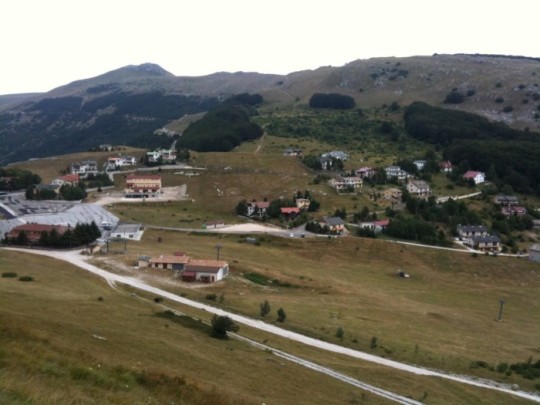
Pintura di Bolognola
Dopo aver cenato ci ritiriamo in camera e programmiamo un’escursione sulla Forcella del Fargno per il giorno successivo. La mattina seguente, tuttavia, la pioggia non ci consente di intraprendere la camminata.
Decidiamo allora di scendere a Sarnano per visitare la mostra sul pittore veneziano Vittore Crivelli (1440–1501/1502) a Palazzo del Popolo. Attiva dal 21 maggio al 6 novembre 2011, la mostra ambisce a offrire una prospettiva originale sul patrimonio artistico della fascia montana delle Marche centromeridionali.
Oltre alle opere di Vittore Crivelli e del più noto fratello Carlo, sono infatti esposte pitture e sculture di altri artisti attivi nei centri più interni delle Marche nella seconda metà del XV secolo, per esplorare il Rinascimento dell’Appennino.
Questo nuovo concetto storico-artistico vuole indicare un Rinascimento di carattere locale, diverso e autonomo dalla più famosa produzione toscana e veneta dell’epoca, legato al gusto per i materiali, l’oro in particolare, e all’ostentazione della ricchezza e dell’eleganza formale.
All’ingresso veniamo informati che il biglietto della mostra permette di visitare anche la pinacoteca comunale, oltre che ottenere tariffe ridotte presso le sedi museali convenzionate dell’Abbadia di Fiastra, Caldarola, Castelraimondo, Falerone, Matelica, Monte Rinaldo, Tolentino, Urbisaglia e Visso.
Alla pinacoteca civica rimaniamo affascinati da due collezioni in mostra al primo piano. Una è dedicata ad armi da fuoco, elmetti e attrezzatura bellica di interesse storico, l’altra a uno strumento di lavoro apparentemente semplice: il martello. Nelle teche di una piccola sala sono esposte decine di martelli di ogni dimensione per altrettanti mestieri, dal martelletto del neurologo al mazzuolo da falegname.
A fine mattinata da Sarnano partiamo alla volta di Fiastra. Alla Casa del Parco, uno dei centri visita dislocati in tutto il territorio del Parco Nazionale dei Monti Sibillini, le guide ci consigliano di pranzare al “Rifugio del Tribbio”.
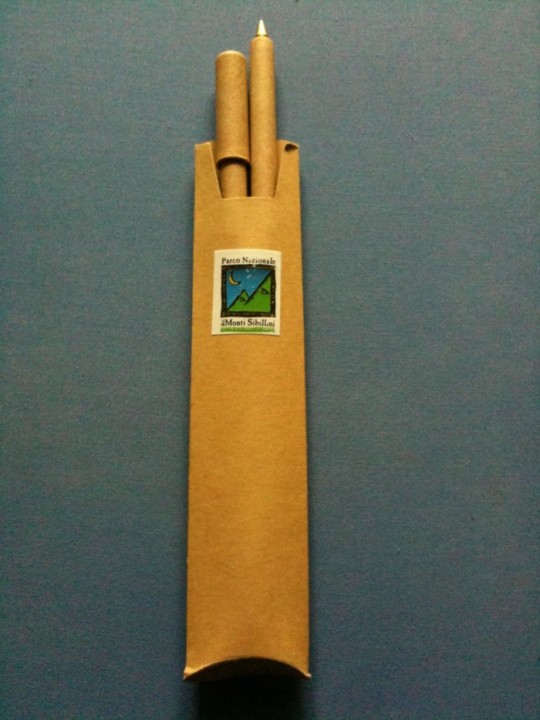
Souvenir della Casa del Parco
Al rifugio veniamo accolti dalla gentile cuoca e proprietaria. L’ambiente e la cucina, tipicamente marchigiana, sono molto gradevoli. Tra le pietanze gustate meritano di essere menzionati i primi piatti, tagliatelle al tartufo e pappardelle ai funghi, e i contorni, zucchine alle erbe aromatiche e melanzane e cipolle in agrodolce.
Mangiata anche una fetta di soffice ciambellone, salutiamo la signora e, usciti dal rifugio, notiamo i romantici ruderi del Castello Magalotti. Il castello era situato sopra un colle, circondato da possenti mura che inglobavano la chiesa benedettina di S. Paolo, in stile puramente romanico.
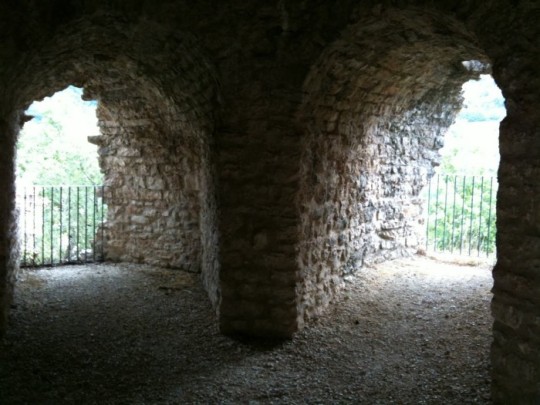
Ruderi del Castello Magalotti
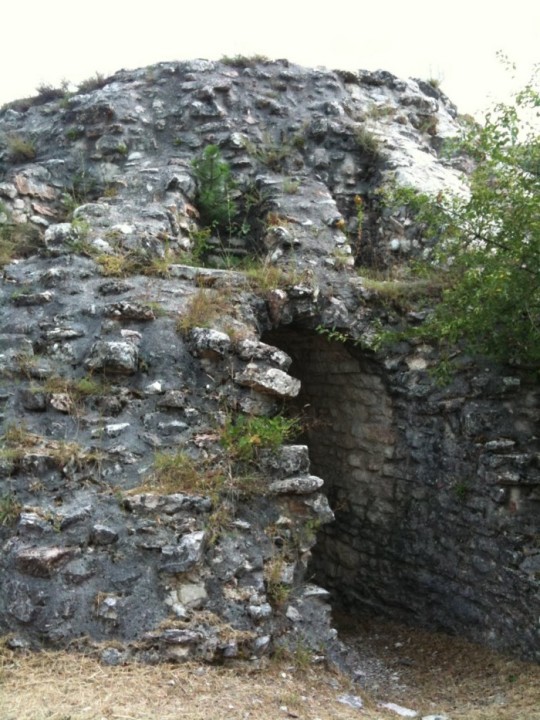
Ruderi del Castello Magalotti
Il colle offre una splendida panoramica dell’intero lago di Fiastra, di cui raggiungiamo le rive a San Lorenzo al Lago per passeggiare un po’ e scattare qualche fotografia prima di ritornare a Pintura di Bolognola.
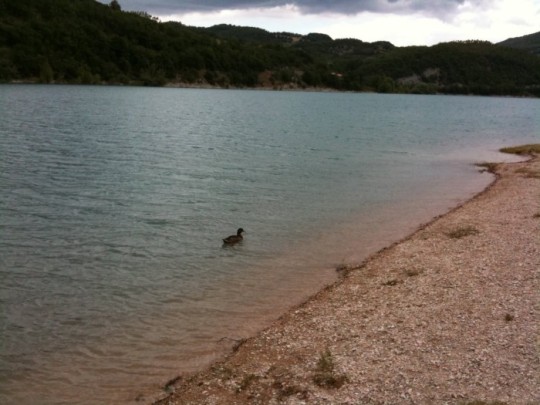
Lago di Fiastra
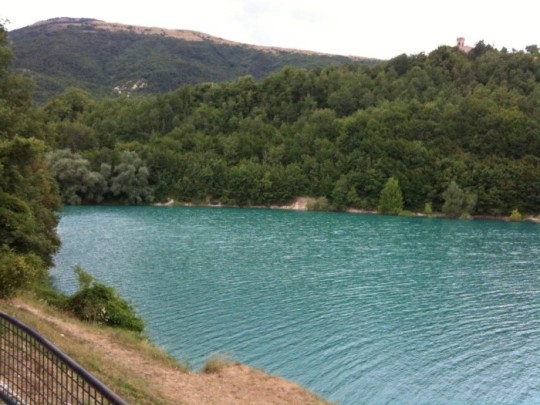
Lago di Fiastra
Nel pomeriggio i nostri programmi sono nuovamente bloccati dalla pioggia. Le ore trascorrono tra cioccolate calde fuori stagione, giochi di carte e lettura di libri e quotidiani disponibili presso il rifugio.
Verso sera, terminato l’acquazzone, effettuiamo un’escursione nei dintorni del rifugio, senza allontanarci troppo per paura del cattivo tempo. La strada è spesso occupata da bellissimi e imponenti tori, vacche e vitelli di razza marchigiana. Lungo il cammino incontriamo il pastore del luogo, che per il giorno successivo ci consiglia di raggiungere il rifugio del Fargno e da lì Pizzo Tre Vescovi, meteo permettendo…
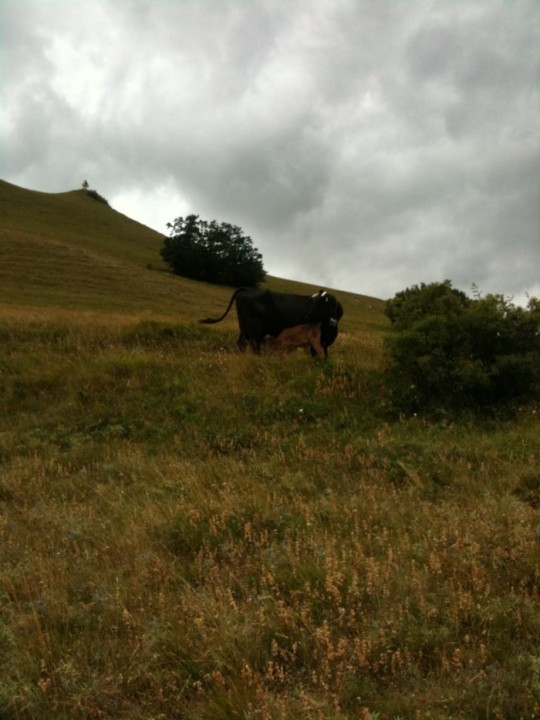
Allattamento di un vitello
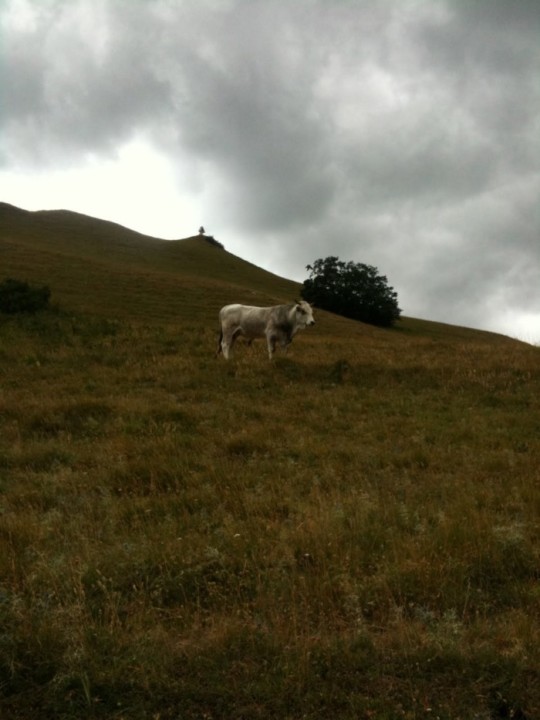
Vitello di razza marchigiana
Dopo la cena in albergo a base di ottimo spezzatino di cinghiale, andiamo a dormire sperando in una bella giornata. La mattina seguente i nostri desideri sembrano esauditi e, dunque, zaino in spalla, ci incamminiamo verso la Forcella della Fargno.
La salita è abbastanza impegnativa: il percorso è lungo circa 6 chilometri e il dislivello è di circa 400 metri, con una fonte d’acqua situata a metà cammino. Volendo è però possibile percorrere abbastanza agevolmente la strada sterrata in automobile o motocicletta.
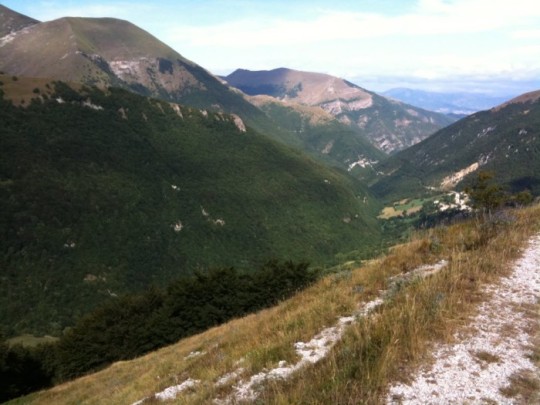
Paesaggio lungo il sentiero verso il Rifugio del Fargno
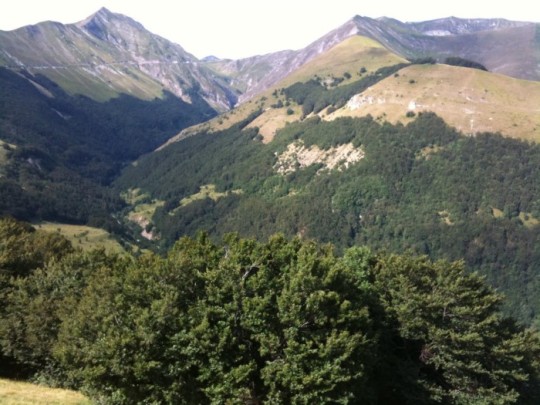
Paesaggio lungo il sentiero verso il Rifugio del Fargno
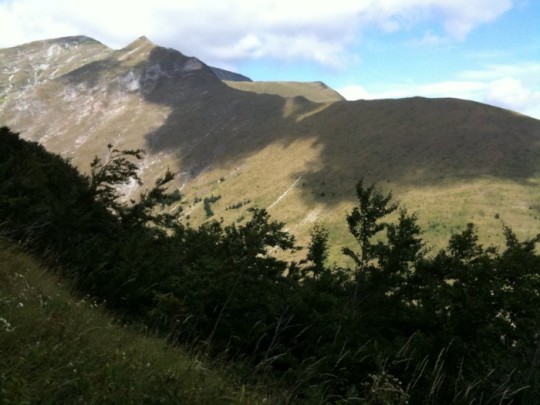
Paesaggio lungo il sentiero verso il Rifugio del Fargno

Paesaggio lungo il sentiero verso il Rifugio del Fargno
Dopo due ore e un quarto di cammino, alle undici e tre quarti circa, raggiungiamo finalmente il rifugio del Fargno, dove ci riposiamo brevemente assaggiando un dolcetto alle mandorle prima di salire ulteriormente sul Pizzo Tre Vescovi.
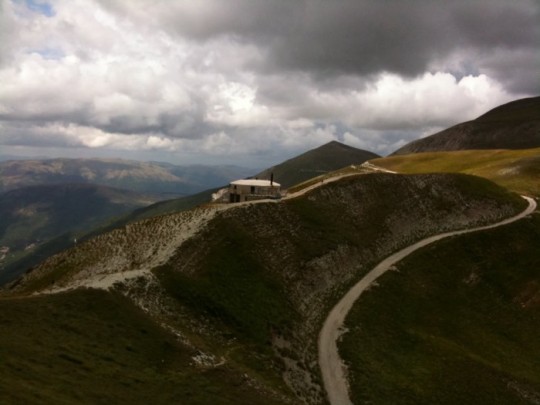
Rifugio del Fargno
Nonostante i nuvoloni in avvicinamento decidiamo di girare tutt’intorno la punta prima di pranzare al rifugio. Il paesaggio è veramente mozzafiato e fotografiamo bellissimi fiori, ma a metà percorso siamo colti nuovamente alla sprovvista dalla pioggia. Pur con qualche difficoltà, affrettiamo il passo e riusciamo a raggiungere il rifugio.

Fiori lungo il sentiero per Pizzo Tre Vescovi
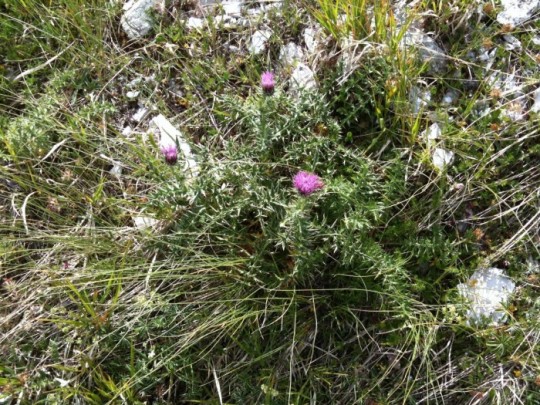
Fiori lungo il sentiero per Pizzo Tre Vescovi
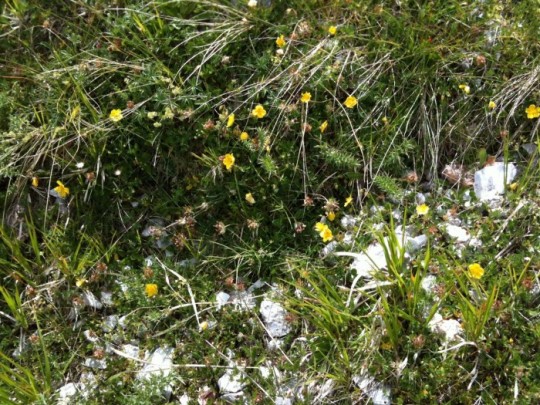
Fiori lungo il sentiero per Pizzo Tre Vescovi
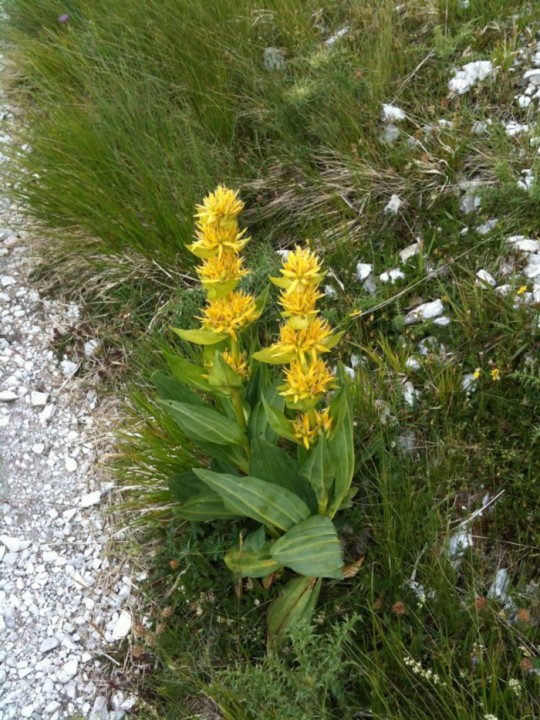
Fiori lungo il sentiero per Pizzo Tre Vescovi
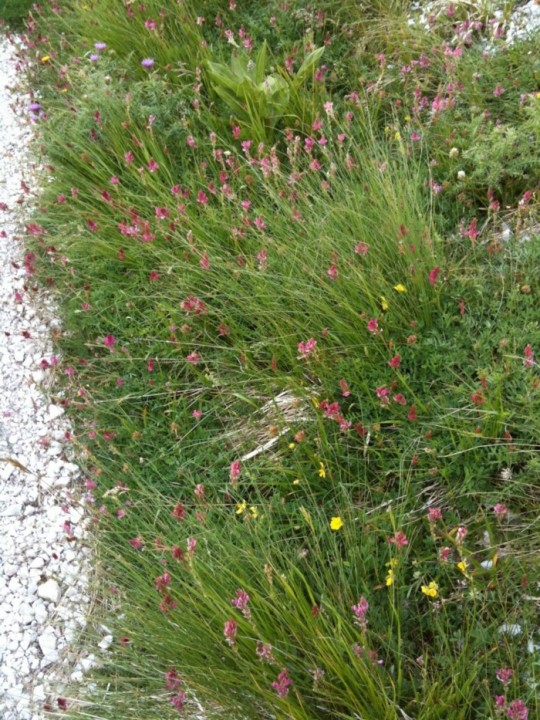
Fiori lungo il sentiero per Pizzo Tre Vescovi
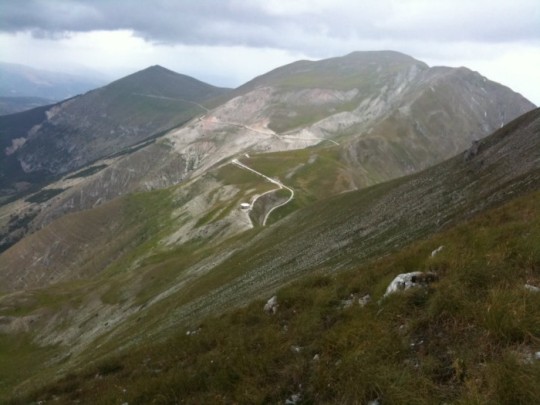
Ritorno al rifugio del Fargno
Il pranzo è decisamente invernale: lenticchie e polenta alla salsiccia, senza lesinare su vino rosso e caffè per contrastare il freddo. Dopo aver sostato un po’ al rifugio, i due più coraggiosi del gruppo, tra cui il sottoscritto, affrontano vento e pioggia ritornando a piedi a Pintura di Bolognola, mentre il terzo compagno, meno intrepido ma più socievole, riesce a strappare un passaggio a delle compagne universitarie incontrate per caso.
Giunti finalmente al nostro albergo ci asciughiamo e cambiamo i vestiti bagnati. Prima di ripartire alla volta di Loreto, compriamo una forma di formaggio, tanto stagionato quanto dolce, prodotta dal cuoco con il latte del pastore che avevamo conosciuto il giorno prima.
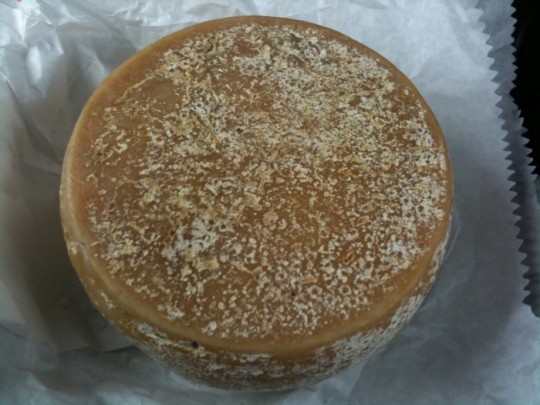
Pecorino dei Monti Sibillini
Pian piano la pioggia comincia a diminuire d’intensità e il sole spunta lungo la via del ritorno dalla nostra piacevole gita estiva in montagna. Speriamo che il racconto del viaggio, di cui conserveremo sempre un bel ricordo, vi abbia divertito e invogliato a visitare i nostri bei Monti Sibillini.
0 notes
Text
City of the future: S+T+ARTS Open Call for Artists, Creatives and Collectives
City of the future S+T+ARTS Open Call for Artists, Creatives and Collectives
Publication: 30 September 2020 Closing date: 30 November 2020
Introduction
STARTS - acronym for Science + Technology + Arts, is a European Commission’s initiative within the European Union Programme for Research and Innovation Horizon 2020, soon Horizon Europe. STARTS supports the Arts as a catalyst for an efficient conversion of scientific and technological knowledge into processes, products and services.
Nesta Italia, supported by Fondazione Compagnia di San Paolo, launches “City of the future”: the Open Call is addressed to Artists, Creatives and Collectives, both italian and european, for the submission of artistic concepts based on emerging technologies (e.g. AI, Big Data, Blockchain, 5G, IoT), considering their applications and usability into an urban and social context (for example, projects aimed at finding medtech solutions for COVID19 or solutions to enhance an ecological transition).
The 3 best proposals will be awarded with 17.000€ each, for the realisation of their artistic project in collaboration with tech companies / research centres based in the Piedmont region, which develop and study the above mentioned technologies. The artist will be allowed to conduct the research and carry out its project in a series of locations: the cultural spaces of Turin (listed below in this document), the tech companies/research centres (if applicable); online or in the public space, if the project specifically addresses community engagement processes.
The winner will develop their proposal between February and May 2021, the outcomes will be exhibited during an international event which will take place in Turin by the end of May 2021.
The Open Call aims to enhance the collaboration between:
- artists, collectives, creatives, who submit their concept and develop the artistic
project during a three-month period of residency;
- companies, research and scientific centres: the “tech partners”, which launch the
tech and social challenge and support the artist sharing knowledge and tools;
- producer: the project manager supervising the artistic production, who coordinates
the different partners involved;
- cultural spaces, which host the artistic residence, providing workspace and general
support in the research and production process.
1
The open call “City of the Future” aims to promote new forms of innovation through artistic practice, raising awareness within the productive system, the scientific community and among citizens. The core of the open call is the artistic project as a driver for alternative paths for the research and development of new technologies, considering the role of these practices in creating more empathic, human-centred applications of technology, thus contributing to the creation of a more inclusive, sustainable and democratic city of the future.
What we want to achieve
The open call is in line with the strategic objectives of Fondazione Compagnia di San Paolo, which aim to increase the attractiveness of italian territories through art and culture, enhance scientific research and accelerate innovation for a sustainable planet. It also reflects the vision of Nesta Italia, which acts to promote art, creativity and technology, in its many forms, as devices for innovation, social equity and economic development.
Through this open call we want to increase the scope of artistic research and practice, to emphasize artistic expression, in order to broaden the horizons and objectives in the development of a technological solution and its applications; moreover, it represents an opportunity for artists, in terms of professional growth and new job opportunities.
The general goal is to enhance long lasting synergies between science, arts and business, as well as between artists, cultural institutions, research centres, public institutions; to promote the role and skills of artists, local initiatives and to spark new economic, social and job opportunities on the regional territory.
The open call represents an opportunity to raise awareness on the future of cities and the urge to develop human-centred technological solutions prioritising the empowerment of urban communities, in order to achieve more sustainable cities and a more fair, green, inclusive and democratic urban future. Furthermore, as a tool favoring the post-COVID recovery, particular attention will be given to projects addressing data for good and medtech.
Finally, through the dissemination of this and other initiatives within the STARTS context, the open call aims at transforming Turin and Piedmont in more attractive and competitive territories, a regional hub of skills, talents, creativity and entrepreneurship.
Who can apply
The call is open to single artists, creatives, collectives from any artistic field, Italian and European, both emerging artists and established ones. It is required that the individual artist or creative is in possession of a VAT number or tax code and resides in Italy or in a different country of the European Union. In the case of art collectives, the group must be traceable to a recognized legal form based in Italy or in a different country of the European Union. The working languages used will be English or Italian, therefore knowledge of one of these two languages is essential.
2
For the purposes of the Call, the author of the artistic project is the natural person who completes and signs the application form (the holder of a VAT number or Tax Code). In the case of collectives, the author is the entire collective, but must be represented by the legal representative of the entity that signs the application form. The call is addressed to people who, through the proposed projects, focus their work on Italian social, urban and ecological challenges, with a particular focus on the city of Turin and the Piedmont region, also taking into account the effects caused by the COVID emergency.
Context and challenge addressed by the Open Call
Talent and artistic research are not yet sufficiently recognized and valued within the development process of a technological product or innovative service by companies or research and innovation centres.
At the same time, technological progress often overshadows the impact that disruptive technologies, such as artificial intelligence and blockchain, can have on people's lives or the perception they have of these innovations.
How can we fully exploit the benefits of emerging technologies, creating solutions that are designed by, with and for people?
Nowadays artists have a hybrid approach to technology: one that is more critical and questions tools and aims of new technologies, the other which points towards new directions and disruptive applications of such technologies, which can benefit both industries and society.
Thus the role of artists in the development of more emphatic technologies, focussed on the needs of society and their potential in grasping and highlighting both the risks and potentialities which are left out of the scientific debate.
The STARTS initiative is therefore interested in:
- artistic projects aimed at engaging communities into the understanding, usage and
implementation of one or more specific technologies;
- artistic projects which use digital technologies to promote innovative use cases or
addresses new audiences;
- artistic projects implemented in the development of tech solutions, in order to make
them more accessible and functional;
- artistic projects addressing the risk and potentialities of new technologies, pointing
toward new directions for scientific research and applications.
"City of the future" does not consider artistic projects in which the technological component constitutes exclusively or primarily a medium for the distribution, use or conservation of works of art born in a traditional context.
Among the positive outcomes we aim to achieve through the Open Call there are:
3
- original solutions or perspectives in the application of a specific technology or scientific innovation;
- new business models enhanced by the contribution of the artistic method;
- new and more efficient ways of introducing and applying new technologies in the
social context, taking into account also their ethical and environmental implications;
- new channels for communication with the general public on these topics;
- greater attention toward the social implications of a new technology during its
development.
Application and submission process
A successful application to the open call requires you to fill out the application form available on Nesta Italia’s website and choose one of the challenges proposed by the tech partners. Each challenge consists of:
- a short description of the social / urban / environmental challenge addressed: - a short description of the technologie/s at the core of the challenge - a list of the resources available for the artists.
From these premises the artist has to present a concept proposal for the production of an artwork.
1. The concept (download the template here) consists of:
- Title and general description highlighting the vision of the project, its originality
and innovation, the quality of the artistic production, the methodology, the congruence between the tech challenge and the artistic project, the expected impact on the city and its community.
- Estimated production costs
- Definition of timing and implementation plan considering the term of
collaboration with the tech/scientific partner, the producer and cultural
space for the artist residency.
- A brief video of the artist/collective presenting the project
- Contact information (in the case of collectives the name of the
representative).
In addition to the concept, it is required:
Valid identity document of the natural person holder of a VAT number / Tax Code or of the legal representative of the proposing entity (in the case of collectives).
The artist’s CV and portfolio (video or presentation of up to 5 previous works, relevant for the call, both national and international, e.g. experiences in the digital field).*
A motivation letter.
4
*In the case of collectives, it will be necessary to attach the CV of the artists who will carry out the artistic production and the portfolio of the collective. If the collective is newly established (up to two years of activity), the CV and portfolio of all the artists involved in the project are required (maximum 3 previous works, relevant for the call).
All documentation listed above will be attached in .pdf format (except the video).
Please note that the participation format offers the possibility of attaching other documentation deemed useful or necessary.
Where necessary, Nesta Italia reserves the right to request additional information for the purposes of the investigation.
The artistic residency
The artist or collective may carry out part of the artistic production within a physical space made available by cultural institutions in the area - among those available in the list.
The artist must indicate in the "concept" (see model in the previous point) how the collaboration will be carried out (how many days, period, etc.). There are no costs charged to the artist.
The producer
The producer is a resource that Nesta Italia makes available to the artist for the entire duration of the residency in order to help him in his artistic exploration, facilitate relations with the partners involved, resolve any problems and coordinate the entire project.
Deadline for applications
All applications should be submitted within 30 November 2020, h. 24:00
Meetings between the parts involved
Nesta Italia will organize a series of events in October in Turin to promote the open call and facilitate meetings between companies, cultural producers and artists. To stay updated on these events, follow Nesta Italia on social media and subscribe to the newsletter on www.nestaitalia.org.
Evaluation and selection process
An independent evaluation committee selects the winning projects, taking into consideration the degree of project feasibility indicated by the potential technological / scientific partners. Priority will be given to artistic projects that focus on the development of people-centered technological solutions for community empowerment and the construction of sustainable
5
cities, for a more circular, inclusive, green and democratic urban future. In addition, in order to facilitate the post-COVID restart, particular attention is paid to projects in the data for good fields, green technologies and technology in the health sector.
The projects will be evaluated according the following criteria:
- Artistic quality and innovation (25 pt): originality of the artistic work, novelty of the
ideas presented and vision developed in relation to the technology of the project. This evaluation will be carried out on the basis of 1. the potential project and 2. the artist's portfolio, with particular mention of both national and international experiences in the digital field.
- Congruence between Art and Science (20 pt): synergy between technological project, the artistic theme and methodological approaches.
- Social Impact (20 pt): the potential social impact of the proposed project.
- Technical approach (15 pt): quality of the development plan (process, planning, stages, specification of respective roles and proposed collaboration framework),
coherence of the cost plan.
- Age (5 pt): five additional points will be awarded to proposing artists under 30 (in the
case of collectives, the age of the legal representative who signs the application form will be considered valid for the score).
The independent evaluation committee draws up a ranking, the top three projects are awarded with a prize of 17,000 euros each.
Results
The results of the selection are published on the Nesta Italia website. The artistic concepts not mentioned in this list must be considered not accepted and therefore excluded from the attribution of the contribution.
The resolution letter sent to the selected projects shows the amount of the approved contribution and the necessary instructions for the disbursement of funds. In order for the funds to be disbursed and the artistic project started, it is necessary that all the parties involved in the project (artist, creative or collective, technological / scientific partner, producer, space partner, Nesta Italia) sign a co-production contract that regulates the collaboration relationship and property rights on artistic production. Creative ownership is held by the artist (or collective of artists), public licenses such as Creative Commons are encouraged to enhance the distribution and dissemination of the work. *
The contract must be signed by 01/31/2021, in order to be able to start the artistic production starting from 02/01/2021.
Payment of the contribution and support of the producer
The grant is disbursed in three installments:
6
- 40% which is disbursed after approval of the budgeted expenses and the signing of a definitive and binding agreement between all interested parties including the "producer" (the co-production contract).
- 40% after the validation of the mid-term project evaluation made by Nesta Italia by 20 March 2021.
- 20% after the validation of the final project evaluation made by Nesta Italia by 20 May 2021.
Nesta Italia reserves the right to carry out monitoring activities on projects in the various stages of their implementation.
Eligible expenses
The following expenses are allowed: - artist/collective fee - costs related to artistic production (e.g. materials) - accommodation costs (here a list of hostels) - communication, dissemination, interaction with the territory, involvement activities - expenses related to setting up the public showcase of the project - specific communication activities for the community, meetings for possible
co-planning and involvement of local associations.
The beneficiaries of the grant must report the expenses by filling in a document made available by Nesta Italia and keeping all the documents proving the expenses incurred (invoices, receipts, receipts) in relation to the artistic project for individual amounts exceeding 50 euro in the period February-July 2021. * During the granting phase, Nesta Italia will verify the correspondence between the budget presented by the artist / collective and the supporting documents for the expenses incurred (which may differ from the estimated expenses up to a maximum of 10%) .
Obligations of the parts involved
The artists, creatives and collectives beneficiaries of the contribution must:
- Carry out the artistic production at the cultural spaces based in Piedmont and selected for the artistic residence (with the possibility of conducting part of the research process at the tech/scientific partner’s venues or online).
Alternatively:
- Carry out the entire research and production process online (in the case of projects that by their nature allow this form), without prejudice to the continuous collaboration with the technological / scientific partner and the possibility of physical meeting with these subjects, where necessary
or
7
- carry out the artistic production in a public space if forms of public art are envisaged to activate community dynamics.
- Engage in the research and development process for three months, from February to May 2021;
- Establish dialogue and collaboration with technological / scientific partners, as well as with local communities, and other stakeholders potentially interested in the project, under the guidance and advice of the producer:
● Regular meetings with Nesta Italia staff and scientific partners, to share the research process, explorations and discoveries.
● Hold at least one lecture, open meeting and / or seminar during the residency (online modalities are also allowed for non-physical residences)
- Produce the artwork (as proposed in the concept) by May 2021.
- Show the outcomes of the residency (whether it be a finished artwork, a prototype or an experimentation) during the final event which will take place in Turin in May 2021
(it is required the artist attendance).
- Keep all documentation (related to production expenses) and make it available to
Nesta Italia if necessary.
The technological / scientific partners must:
- Make available for the artist the necessary knowledge as well as the technology
object of the challenge.
- If applicable, offer to the artist a workspace and access to wifi in the company /
research center venue for the research process.
- Identify a person in charge of relations with the artist (engineer, scientist) who makes
himself available to resolve doubts, questions, technical curiosities.
- Establish a dialogue and collaboration with the artist, as well as facilitate a dialogue
with local communities, and other stakeholders potentially interested in the project.
- Regularly meet Nesta Italia staff to share the research process, any doubts,
explorations and discoveries that will intervene in the path.
- Produce a final report at the end of the residency.
- Promote the Open Call through the communication channels, according to the
guidelines provided by Nesta Italia.
The cultural spaces partners must:
- Offer a workspace for production to the artist / collective for at least 30 days during
the period February - May 2021.
- Enhance meetings between all different partners involved in the project at the
residency venue.
- Establish a dialogue and collaboration with the artist, as well as facilitate a dialogue
with local communities, and other stakeholders potentially interested in the project.
8
- Promote the artistic project as well as the STARTS initiative through their communication channels ,according to the guidelines provided by Nesta Italia.
Contacts
For further information about the project write us at [email protected]
0 notes
Photo

Sulle pendici di un colle piemonteese, in provincia di Cuneo, sorge in una posizione incantevole il piccolo borgo medioevale di Monforte d’Alba. Parte del circuito dei Borghi più belli d’Italia sin dal 2008, appartiene al gruppo degli undici comuni che producono il vino Barolo e dell’Unione di comini Colline di Langa e Barolo. Le stradine strette, a Monforte d’Alba, conducono sino alla piazza centrale Antica Chiesa e al famoso anfiteatro a cielo aperto: da qui la vista sui vigneti è qualcosa di magico. Soprattutto al tramonto, quando si trasforma in un paesaggio dai colori mozzafiato. Sarà per questo che – quei vigneti – sono da poco tempo stati dichiarati Patrimonio dell’Umanità dall’UNESCO. Il borgo di Monforte d’Alba | Ph. Coscarella Gianfranco (iStock) Cosa vedere nel piccolo borgo Il cuore di Monforte d’Alba risiede nella parte antica del borgo, arroccata su di una collina che domina la parte nuova del comune. Qui l’Auditorium Horszowski, l’anfiteatro naturale ricavato dalla pendenza del terreno e inaugurato dall’omonimo musicista nel 1986, vede tutto un susseguirsi di gradoni rivestiti d’erba. Il palco è stato realizzato con un muro di cinta e, a dominare, è quella torre campanaria unico resto dell’antica chiesa medioevale andata distrutta. Il risultato? Un’acustica perfetta, che ha fatto che sì che musicisti del calibro di Paolo Conte abbiano organizzato qui diversi concerti, e che la rassegna internazionale Monfortinjazz sia ormai un appuntamento imperdibile nel mese di luglio. Stradine di Monforte d’Alba | Ph. Kloeg008 (iStock) Nella parte vecchia, gli antichi palazzi nobiliari e borghesi sono stati restaurati e si ergono come piccole e preziose opere d’arte, tra la costruzione barocca dell’Oratorio di S. Elisabetta e la facciata della Chiesa dei Disciplinati. Le Meridiane ancora visibili sono due: quella in via Del Carretto presenta al centro una clessidra alata; l’altra, in via Vallada, sulla torre annessa al palazzo già Martina, reca in alto la scritta “Soles occidere et redire possunt nobis cum semel occidit brevis lux, nox est perpetua una eterna dormenda” di Catullo (“Il sole può calare e ritornare per noi, quando la breve luce cade resta una eterna notte da dormire”). Nella parte nuova si trova invece la chiesa di Monforte, realizzata dall’architetto Giuseppe Gallo di Torino e terminata nel 1912: lo stile neogotico con pianta a croce latina si accosta al campanile, all’ampia gradinata e alla facciata divisa in tre corpi verticali. Se volete tornare bambini per un attimo, troverete inoltre due panchine giganti del progetto creato dal designer Chris Bangle: la misura, enorme, vi permetterà di sentirvi un po’ comeAlice nel paese delle meraviglie. Ovviamente non possono mancare le numerose cantine dove brindare con dell’ottimo vino tipico di questa zona, ideale per accompagnare i sapori e i profumi del cibo. Monforte d’Alba | Ph. Coscarella Gianfranco (iStock) Enogastronomia d’autore Il borgo di Monforte d’Alba offre molto al visitatore per quanto riguarda la cultura enogastronomica. L’influenza della Liguria e della Valle d’Aosta si ritrova nella gustosa “bagna cauda” e nella fonduta. Tra gli altri piatti tipici il vitello tonnato, la carne cruda all’albese, le frittate, il fritto misto alla piemontese, il tajarin, i ravioli al “plin”, gli gnocchi di patate e le lasagne al sangue. Come dimenticare poi il brasato al Barolo o il bollito misto accompagnato dal bagnet verd? Tutto ovviamente da concludersi con le “Tume”, il “bonet”, la torta di nocciole o le paste secche di meliga con lo zabaione. E solo per gli intenditori, del fungo ipogeo per eccellenza, il profumato e prezioso tartufo d’Alba. Per concludere con gusto la visita ad un borgo magico. I vigneti sulle colline Ph. MicheleVacchiano (iStock) https://ift.tt/2OiD5Rk Monforte d’Alba, un borgo medievale tra i vigneti del Piemonte Sulle pendici di un colle piemonteese, in provincia di Cuneo, sorge in una posizione incantevole il piccolo borgo medioevale di Monforte d’Alba. Parte del circuito dei Borghi più belli d’Italia sin dal 2008, appartiene al gruppo degli undici comuni che producono il vino Barolo e dell’Unione di comini Colline di Langa e Barolo. Le stradine strette, a Monforte d’Alba, conducono sino alla piazza centrale Antica Chiesa e al famoso anfiteatro a cielo aperto: da qui la vista sui vigneti è qualcosa di magico. Soprattutto al tramonto, quando si trasforma in un paesaggio dai colori mozzafiato. Sarà per questo che – quei vigneti – sono da poco tempo stati dichiarati Patrimonio dell’Umanità dall’UNESCO. Il borgo di Monforte d’Alba | Ph. Coscarella Gianfranco (iStock) Cosa vedere nel piccolo borgo Il cuore di Monforte d’Alba risiede nella parte antica del borgo, arroccata su di una collina che domina la parte nuova del comune. Qui l’Auditorium Horszowski, l’anfiteatro naturale ricavato dalla pendenza del terreno e inaugurato dall’omonimo musicista nel 1986, vede tutto un susseguirsi di gradoni rivestiti d’erba. Il palco è stato realizzato con un muro di cinta e, a dominare, è quella torre campanaria unico resto dell’antica chiesa medioevale andata distrutta. Il risultato? Un’acustica perfetta, che ha fatto che sì che musicisti del calibro di Paolo Conte abbiano organizzato qui diversi concerti, e che la rassegna internazionale Monfortinjazz sia ormai un appuntamento imperdibile nel mese di luglio. Stradine di Monforte d’Alba | Ph. Kloeg008 (iStock) Nella parte vecchia, gli antichi palazzi nobiliari e borghesi sono stati restaurati e si ergono come piccole e preziose opere d’arte, tra la costruzione barocca dell’Oratorio di S. Elisabetta e la facciata della Chiesa dei Disciplinati. Le Meridiane ancora visibili sono due: quella in via Del Carretto presenta al centro una clessidra alata; l’altra, in via Vallada, sulla torre annessa al palazzo già Martina, reca in alto la scritta “Soles occidere et redire possunt nobis cum semel occidit brevis lux, nox est perpetua una eterna dormenda” di Catullo (“Il sole può calare e ritornare per noi, quando la breve luce cade resta una eterna notte da dormire”). Nella parte nuova si trova invece la chiesa di Monforte, realizzata dall’architetto Giuseppe Gallo di Torino e terminata nel 1912: lo stile neogotico con pianta a croce latina si accosta al campanile, all’ampia gradinata e alla facciata divisa in tre corpi verticali. Se volete tornare bambini per un attimo, troverete inoltre due panchine giganti del progetto creato dal designer Chris Bangle: la misura, enorme, vi permetterà di sentirvi un po’ comeAlice nel paese delle meraviglie. Ovviamente non possono mancare le numerose cantine dove brindare con dell’ottimo vino tipico di questa zona, ideale per accompagnare i sapori e i profumi del cibo. Monforte d’Alba | Ph. Coscarella Gianfranco (iStock) Enogastronomia d’autore Il borgo di Monforte d’Alba offre molto al visitatore per quanto riguarda la cultura enogastronomica. L’influenza della Liguria e della Valle d’Aosta si ritrova nella gustosa “bagna cauda” e nella fonduta. Tra gli altri piatti tipici il vitello tonnato, la carne cruda all’albese, le frittate, il fritto misto alla piemontese, il tajarin, i ravioli al “plin”, gli gnocchi di patate e le lasagne al sangue. Come dimenticare poi il brasato al Barolo o il bollito misto accompagnato dal bagnet verd? Tutto ovviamente da concludersi con le “Tume”, il “bonet”, la torta di nocciole o le paste secche di meliga con lo zabaione. E solo per gli intenditori, del fungo ipogeo per eccellenza, il profumato e prezioso tartufo d’Alba. Per concludere con gusto la visita ad un borgo magico. I vigneti sulle colline Ph. MicheleVacchiano (iStock) Patria del Barolo e del “bagnet verd”, Monforte d’Alba si caratterizza per l’anfiteatro naturale casa di concerti jazz.
0 notes
Text
Artista fra due secoli
Nel 1796, appena 20 giorni dopo l’ingresso del generale Bonaparte a Milano, “Il Corriere milanese ossia il Cittadino Libero del 9 giugno 1796” riportava la notizia della consegna a Napoleone di un suo ritratto eseguito di nascosto da Andrea Appiani. Era l’inizio di un’amicizia destinata a occupare il resto della vita del pittore, ormai in età matura (era nato a Milano il 31 maggio 1754, dove morì l’8 novembre 1817) e affermato ritrattista oltre che autore di affreschi nelle chiese lombarde, ultimi prima dell’arrivo dei Francesi quelli in Santa Maria presso S. Celso.

Nelle solenni esequie per la sacra cesarea reale apostolica maestà di Leopoldo secondo imperatore e re celebrate nella Imperiale Regia Collegiata di S. Maria della Scala in S. Fedele, orazione funebre recitata il giorno 21 marzo 1792 da Stefano Bonsignore della congregazione degli obbl. dott. del Coll. Ambrosiano lett. di teologia dogmatica e prefetto degli studi nel Seminario arcivescovile di Milano. - In Milano : nell'imperial Monistero di S. Ambrogio Maggiore, 1792
Con l’instaurazione della Repubblica cisalpina fu adottato il calendario rivoluzionario in vigore in Francia già dal 1793, il cui impiego si limitò in effetti ai documenti ufficiali, dal momento che la Repubblica garantendo la libertà di culto permetteva alla cittadinanza di continuare a seguire i riti tradizionali e le celebrazioni religiose pur ponendo ogni limite possibile alle devozioni pubbliche, moltiplicando invece le occasioni per le feste civili sia per commemorare sul modello parigino le date della rivoluzione che le vittorie napoleoniche. Col declinare degli ideali giacobini, alle processioni davanti all’albero della libertà succedettero celebrazioni più articolate, sul modello delle feste parigine del Direttorio, ambientate in luoghi architettonicamente dedicati al loro svolgimento: nell’area dell’ex Lazzaretto, inaugurata dalla “Festa della Federazione”; nei giardini di Porta Orientale e nell’area libera di Foro Bonaparte dove si celebrò il 26 giugno 1803 la nascita della Repubblica Italiana. La manifestazione del 1803 fu affidata alla regia di Andrea Appiani che, nei giorni dei festeggiamenti, presentò anche i primi pannelli dei Fasti napoleonici destinati a ornare la Sala delle Cariatidi di Palazzo Reale fino ai bombardamenti del 1943. Lungo i viali diritti dei Boschetti di via Marina fiancheggiati dai tigli, furono allora inseriti, sul modello dell’Antichità, trofei ed emblemi, mentre intorno vennero erette giostre e altri apparati per il divertimento popolare. Sull’area del Foro furono invece ripresi i giochi circensi in una struttura temporanea di legno e tela, progettata sui modelli antichi, che Luigi Canonica si occupò di trasformare in muratura di lì a qualche anno, precisamente in occasione dell’ingresso di Napoleone in città nel dicembre del 1807.

Sul modello delle feste parigine (qui l’arco di trionfo eretto davanti al giardino delle Tuileries in occasione del matrimonio fra Napoleone e Maria-Luisa d’Austria), anche Milano si dotò di architetture celebrative effimere specie lungo il Corso di Porta Orientale, oggi Corso Venezia. Fêtes à l'occasion du mariage de s.m. Napoléon, empereur des français, ... avec Marie-Louise, archiduchesse d'Autriche. Recueil de gravures au trait, représentant les principales décorations d'architecture et de peinture et les illuminations ..., avec une description, par m. Goulet. - Paris : L.C. Soyer, 1810 ([Parigi! : de l'imprimerie de Chaignieau aine, rue de la Monnaie, n. 11).
Il cambiamento di regime non aveva comunque segnato un mutamento di status e di attività per il poliedrico artista (come del resto per Piermarini, Canonica, Landriani, ecc.), scenografo per la Scala, designer ante litteram per i mobili dell’atelier Maggiolini e illustratore.

Memorie appartenenti alla vita ed agli studj del signor don Paolo Frisi ... / [Pietro Verri]. - In Milano : nella stamperia di Giuseppe Marelli, 1787
Molteplici erano stati gli impieghi delle arti figurative e applicate nei riti e nelle cerimonie delle società di Antico regime. L’arte era sempre in qualche modo arte applicata, giustificata da scopi concreti, dall’attitudine a servire a qualche momento della vita. Lo stesso Leonardo da Vinci, che incarna per i contemporanei in modo eminente il tipo del genio, si occupò in effetti proprio a Milano degli apparati effimeri per i festeggiamenti di Ludovico il Moro. Anche per la più immateriale delle arti: la musica il grande numero di documenti scritti rimasti per quella che noi chiamiamo “musica ufficiale”, conferma l’impressione che costituisse in realtà il principale compito per i compositori. Nella festa, civile e religiosa (sarebbe difficoltoso tracciare fra le due tipologie una netta linea di confine), si esprimeva in modo eminente l’unità fra arte e vita. La festa si svolgeva comunque secondo una liturgia che, nella tensione ad essere in sé bella, si valeva degli apporti essenziali degli artisti.
Il mutamento epocale per lo stato delle arti si stava preparando invece in quegli stessi anni nella politicamente frammentata Germania: per la generazione romantica l’unità di arte e vita era prerogativa del genio, cioè di colui nel quale l’energia creatrice poteva fluire liberamente concretizzando in simboli sempre nuovi il perenne divenire dello spirito, preferibilmente in contrasto col “filisteismo” del pubblico. Questa esaltazione del soggettivismo estetico era destinata a informare di sé avanguardie e neoavanguardie, fino ad oggi.
Nella sua ironica rappresentazione del genio, Appiani sembra avere avuto sentore dei tempi nuovi.

Andrea Appiani, il genio dell’Arte e gli invidiosi, inizi secolo XIX, affresco riportato su tele, Galleria d’Arte Moderna, Milano.
1 note
·
View note
Text
Frosinone, Ceccano, Patrica torna la puzza merdosa, scuole in difficoltà per le lezioni all'aperto
Attività fisica interrotta nelle scuole che si affacciano sulla piana del fiume Sacco, nei pressi del depuratore per la puzza merdosa che con le prime nebbie autunnali si è puntualmente ripresentata a stringere le gole di quanti si trovano all’aria aperta in quell’area compresa tra l’aeroporto di Frosinone, Corso Lazio, variante Casilina, le contrade Colle S. Paolo e Callami di Ceccano, siano ai…

View On WordPress
0 notes
Text

Cervo ferito
8 - In quel volo spirituale l'anima volentieri si sarebbe separata dal corpo, credendo che la sua vita stesse per finire e che ella potesse godere per sempre lo Sposo e rimanere svelatamente con Lui.
Lo Sposo invece le impedisce di andare avanti dicendo: Volgiti, o colomba, vale a dire: O colomba, nel volo alto e agile di contemplazione che tu fai, nell'amore con cui ardi e nella semplicità con cui ti muovi ( la colomba ha queste tre proprietà ) torna indietro da questo volo alto per mezzo del quale desideri giungere veramente a possedermi, poiché ancora non è giunto il tempo di una conoscenza così sublime; accomodati invece a questa più imperfetta che io ti comunico in questo tuo trasporto.
Poiché il cervo ferito.
9 - Lo Sposo si paragona al cervo poiché in questo luogo per cervo intende se stesso.
C'è da sapere che è proprietà del cervo quella di salire sulle alture; quando è ferito se ne va in gran fretta a cercare refrigerio nelle acque fredde e se ode il lamento della compagna e sa che è ferita, corre subito a lei, l'accarezza e la vezzeggia.
Così fa ora lo Sposo poiché, vedendo la sposa ferita del suo amore e udendone il gemito, viene ferito dall'amore di lei giacché tra gli innamorati la ferita dell'uno è ferita dell'altro e unico è il sentimento che hanno.
Perciò è come se dicesse: Torna indietro verso di me, o sposa mia, poiché se tu sei stata ferita dall'amore mio, anch'io, come il cervo ferito da questa tua piaga, vengo a te.
Inoltre, come il cervo, Egli spunta dall'alto, perciò dice:
sull'alto colle spunta
10 - Cioè dall'alto della contemplazione che possiedi in questo volo.
Essa infatti è un'altura su cui Dio, in questa vita, incomincia, senza mai cessare, a comunicarsi e a mostrarsi all'anima.
Perciò non afferma che Dio appare, ma che spunta poiché, per quanto sublimi siano le notizie di Dio ricevute dall'anima in terra, sono simili ad apparizioni molto rapide.
Segue la terza delle accennate proprietà del cervo, contenuta nel verso seguente:
all'aura del tuo volo e il fresco prende.
11 - Per volo si intende la contemplazione propria dell'estasi di cui è stato parlato e per aura lo spirito di amore causato nell'anima da questo volo.
A questo amore causato dal volo essa molto giustamente dà il nome di aura poiché anche lo Spirito Santo, che è amore, nella Sacra Scrittura è paragonato all'aura, in quanto viene spirato dal Padre e dal Figlio.
Come Egli lì è aura prodotta dal volo, poiché procede e viene spirato dalla contemplazione e sapienza del Padre e del Figlio, così quest'amore dell'anima viene chiamato qui dallo Sposo aura perché procede dalla contemplazione e dalla conoscenza di Dio possedute attualmente da lei.
C'è da notare come in questo verso lo Sposo non afferma di venire al volo, ma all'aura del volo giacché Dio propriamente non si comunica all'anima per mezzo del volo, che consiste nella conoscenza che ella ha di Dio, ma mediante l'amore derivato dalla conoscenza: come l'amore è unione del Padre e del Figlio, così unisce anche l'anima e Dio.
Da ciò proviene che, per quanto un'anima abbia sublimi notizie di Dio, sia dotata di contemplazione e conosca tutti i misteri, come afferma S. Paolo, in nessun modo se ne potrebbe servire per l'unione con il Signore se non possedesse l'amore ( 1 Cor 13,2 ); infatti l'Apostolo in un altro testo dice: Charitatem habete, quod est vinculum perfectionis ( Col 3,14 ) - Abbiate la carità, che è il vincolo della perfezione.
Pertanto questa carità o amore dell'anima fa in modo che lo Sposo corra a bere alla fonte amorosa della sposa, come le acque fresche invitano il cervo sitibondo e piagato a correre per refrigerarsi.
Perciò essa soggiunge:
e il fresco prende.
12 - Come l'aria rinfresca refrigerandolo chi è affaticato dal caldo, così quest'aura d'amore porta refrigerio e reca sollievo a chi arde d'amore, poiché questo ha la proprietà di essere refrigerato da un'aria che è un altro fuoco d'amore, dato che nell'amante l'amore è fiamma che arde accompagnata dal desiderio di ardere di più, simile in ciò alla fiamma del fuoco naturale.
Pertanto lo Sposo chiama prender fresco l'adempimento del proprio desiderio di ardere maggiormente nella fiamma dell'amore della sposa, cioè nell'aura del volo di lei.
Perciò è come se dicesse: all'ardore del tuo volo, io brucio di più, poiché un amore ne accende un altro.
È necessario notare che Dio infonde nell'anima la sua grazia e il suo amore in proporzione alla volontà e all'amore di essa.
Per questo il vero innamorato deve procurare che tale amore non venga mai meno poiché, per mezzo di esso, spingerà di più il Signore, se così si può dire, ad amarlo di più e a trovare maggiormente diletto nell'anima sua.
Per conseguire questa carità si deve fare quanto insegna l'Apostolo ( 1 Cor 13,4-7 ): La carità è potente, è benigna, non è invidiosa, non fa del male, non si insuperbisce, non è ambiziosa, non cerca le proprie cose, non si irrita, non pensa male, non si rallegra della malvagità, gode della verità, soffre tutte le cose che sono da soffrire, crede a tutte le cose che si devono credere, spera e sopporta tutto ciò che le conviene.
San Giovanni della Croce (Cantico Spirituale)
---
La fede ci segnala la fonte da cui nascono le sofferenze. È l’Amore di Dio che prova, purifica ed affina il discepolo. Quando soffrirai guarda Gesù perché ti sta facendo partecipe della Sua Croce.
S. Teresa di Los Andes
0 notes
Text
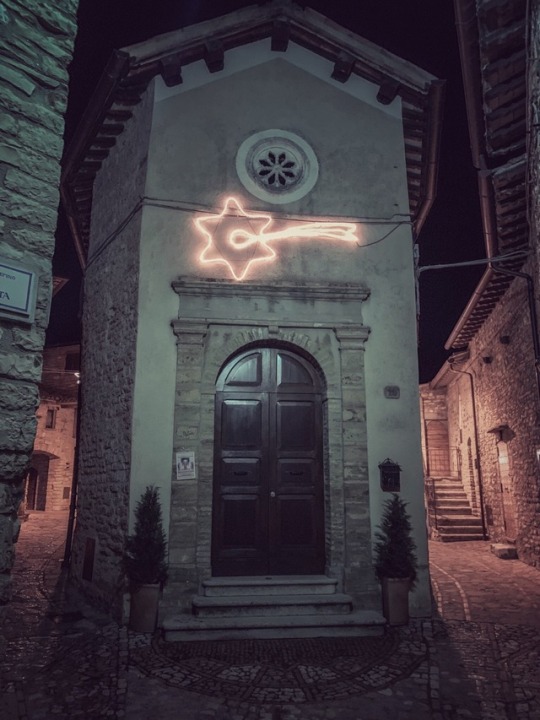
Cenni storici
Collepino, anticamente detta Colle-Lupino (Colle del Lupo) o Collepieno, è un piccolo castello dell’alto medioevo appollaiato sulle pendici orientali del Monte Subasio.
È a quota 600 metri s.l.m. e dal suo promontorio, sempre illuminato dal sole, si gode l’ampio panorama del torrente Chiona, della città di Foligno e della Valle Spoletana della quale S. Francesco disse: – “NIHIL IUCUNDIUS VIDI VALLE MEA SPOLETANA” – non ho visto niente più bello della mia Valle Spoletana.
Fondato presumibilmente da pastori, coloni e boscaioli della zona, questo piccolo paese fa il suo ingresso nella storia quando l’Abbazia di San Silvestro, costruita nel 523 da San Benedetto a due chilometri circa da Collepino, diventa Camaldolese ad opera del ravennate San Romualdo abate, nel 1025.
Si parla di una prima famiglia, quella degli Acuti, alla quale successero gli Urbani; capostipite di questi ultimi fu un certo Ser Nicolò, creato cavaliere e conte palatino dall’Imperatore Ottone IV nel 1210.
Le vicende di Collepino sono legate al Ducato di Spoleto, alla abazia di S. Silvestro, al Comune di Spello, alle Signorie perugine, allo Stato Pontificio.
Tralasciando gli altri periodi, ci interesseremo particolarmente delle Signorie che più funestarono l’Umbria, le sue città, i suoi castelli, la prima che ci riguarda da vicino è quella di un certo Bartoloccio.
Fino al 1340 circa, Collepino era stato un Castello del Comune di Spello e gli Urbani ne erano stati i castellani.
Nel Medioevo, dal 1347 la troviamo indipendente sotto la Signoria di un certo Ser Bartoloccio di Ser Giacomo.
Le notizie che abbiamo su questo Bartoloccio sono imprecise e contrastanti.
Secondo il Donnola era costui uno spadaccino di ignoto casato che, dopo aver tenuta soggiogata Spello e combattuto contro il Ducato di Spoleto per allargare i suoi confini a spese dello Stato Pontificio, fu cacciato dalla città nel 1352 dal Cardinale Egidio Albornoz e mandato dal Papa Innocenzo VI a Spoleto in qualità di Vicelegato.
Gli spellani respirarono e si misero volentieri sotto la protezione del Ducato per liberarsi da questo despota.
Cacciato da Spello, il Bartoloccio si rifugiò fra i boschi vicino a Collepino e da qui faceva frequenti incursioni a Spello, con le sue soldatesche, tenendo nel terrore la popolazione.
Il Cardinale a questo punto, per rabbonirlo, gli affidò il comando di Collepino, mettendogli a disposizione due guardie per la vigilanza del Castello (pagate due scudi al mese) e due Consoli per l’amministrazione della giustizia.
Questi ultimi avevano uno stipendio di tre scudi al mese e potevano multare fino ad un massimo di tre scudi.
Ma, presumibilmente per il suo malgoverno, il Bartoloccio fu rimosso dalla sua carica dalla Camera Apostolica nel 1369 e tutti i suoi beni furono confiscati.
Secondo gli Olorini invece nel 1354 Collepino, mettendosi nelle mani di Bartoloccio di Ser Giacomo Urbani, capo dei Ghibellini, si ribella alla Santa Sede.
Il vescovo di Firenze Filippo Antella, rettore del Ducato di Spoleto, ordina l’assalto contro i collepinesi che, nonostante il grande valore dimostrato, devono arrendersi a discrezione.
Intanto a Spello muore Pietro di Maurizio Targarino e a Collepino Cecco di Ser Matteo d’Urbano; il Comune di Spello chiede al Papa di eleggere come Gonfaloniere Bartoloccio di Ser Giacomo.
A questo scopo invia ad Avignone don Francesco di Ser Giacomo, segretario del cardinale di S. Croce e fratello del Bartoloccio.
Dopo quattro mesi don Francesco ritorna da Avignone con il titolo di Vescovo di Ippona e Abate dell’abazia di Venafro (Isernia-Molise) per sé, e con la carica di Gonfaloniere a vita di Spello e Collepino per il fratello Bartoloccio.
Per questo nomine furono fatti molti festeggiamenti sia a Spello che a Collepino.
All’inizio Bartoloccio si mostrò molto generoso: liberò i prigionieri pagando i loro debiti, fece molte elemosine ai poveri, sistemò molte giovani maritandole o monacandole ed usò molte equità anche con i delinquenti.
Nel 1359, recatosi ad Avignone per ossequiare il Papa, si vide confermato il titolo di Gonfaloniere a vita di Spello e Collepino.
Ma nel 1366, in combutta con un certo Vico, detto il Rosso per il colore dei suoi capelli, comincia a tiranneggiare Spello e il contado.
Il Comune lo fa riprendere dal fratello vescovo e Bartoloccio momentaneamente si pente.
Morto il fratello, che lo lascia erede dei suoi beni, si vendica contro i nobili di Spello che volevano liquidarlo e, sobillato dal Vico, fa uccidere Giovanni degli Urbani insieme a molti altri avversari, altri li fa gettare dalla rupe di Collepino e fa scannare numerose donne perché favorevoli ai suoi avversari.
Il Comune di Spello allora, con il permesso del Rettore del Ducato di Spoleto, Cardinale Egidio Albornoz, inviò Francesco di Ser Pietro fu Targarini, con molti uomini armati, alla casa del Bartoloccio che fu bruciata.
Bartoloccio e il Vico riuscirono però a fuggire e per qualche tempo seminarono il terrore nelle campagne uccidendo, rubando e usando la violenza.
Mentre fuggivano verso Assisi, furono sorpresi dagli armati del Comune e uccisi.
Dopo Bartoloccio ci furono a Collepino numerosi altri reggenti ed uno di costoro esigeva la riparazione delle mura di Collepino a spese del Comune di Spello, il cui Governatore, signor Nello Baglioni, nominò come giudice Messer Spinello de Spini di Ascoli nel 1431.
Quest’ultimo sentenziò che il Comune non era obbligato a riparare dette mura.
Nel 1460 Braccio Baglioni, comandante delle truppe pontificie, per assicurarsi la Signoria di Perugia, uccise il cugino Pandolfo ed il nipote Nicolò.
La frenesia del potere scatenò tra i familiari una serie di congiure e stragi che terminarono in una lotta ferocissima nel luglio del 1500, che estinse quasi il casato.
L’unico superstite Gianpaolo Baglioni, dopo essersi crudelmente vendicato su tutti i suoi avversari, estese il suo dominio su tutta l’Umbria; a Collepino, a ricordo del suo dominio, fissò lo stemma del suo casato: IL GRIFO RAMPANTE E CORONATO tuttora visibile presso la porta del Castello. Nel 1534 Papa Paolo III, per le necessità dello Stato Pontificio, lasciato esausto da Clemente VII per le guerre contro i Turchi e la costruzione della Basilica di S. Pietro, aumentò di tre quattrini a libbra il prezzo del sale.
Perugia, con Rodolfo Baglioni e numerosi altri Comuni, reagì a questo provvedimento ribellandosi al Papa, uccidendo il Legato Pontificio, Vescovo di Terracina, con tutti i suoi consiglieri riuniti in seduta.
Il cronista del tempo, Cesari Bontempi scrive che a Perugia non si era mai vista una strage così crudele.
Paolo III inviò allora un rinforzo di truppe di 10.000 soldati per sbaragliare i ribelli. Perugia fu “ripulita” da tutti i rivoltosi.
Per la zona di Spello l’incarico fu affidato al Vicelegato di Foligno Giovanni Battista Savelli il quale riuscì a recuperare Spello e i Castelli vicini.
In questa circostanza furono demolite le mura di Collepino perché dentro di esse si erano rifugiati i partigiani dei Baglioni, diventati nemici dello Stato Pontificio.
Stessa sorte toccò all’abazia di S. Silvestro che fu rasa al suolo.
Si era arrivati all’anno 1535. Intanto Paolo III a Perugia, sulle case distrutte dei Baglioni, fece erigere da Antonio Sangallo il giovane, nel 1541 una fortezza che dal suo nome fu chiamata ROCCA PAOLINA, “Ad repellendam audaciam perusinorum” per respingere l’audacia dei perugini.
Con la sottomissione di Perugia, anche Collepino tornò sotto lo Stato Pontificio, accogliendo tra le sue mura un Presidio militare, con sede in una casa ancora esistente ed abitata, che si trova sulla destra presso la porta del Castello. Queste guardie a Collepino diedero origine alle più antiche famiglie: Antiseri, Bevilacqua, Quinti e Cristiani.
Tornata la pace, questo laborioso Castello passò sotto la saggia guida del Preposto Abate di S. Silvestro e sentì solo da lontano l’eco delle guerre successive fino a che non fu proclamato il Regno d’Italia nel 1861.
Da antichi documenti, risalenti al secolo scorso risulta che Collepino, entro e fuori le mura, contava 80 fuochi (famiglie), all’incirca 500 persone.
Da un documento stilato da Don Giovanni Buccilli si sa che al 31 Dicembre 1939 gli abitanti erano 355.
Dopo la seconda guerra mondiale è iniziato un inarrestabile processo di emigrazione e fino agli anni 80 nella parrocchia di Collepino si contavano circa 110 persone: una trentina entro le mura, gli altri nella valle del torrente Chiona, attualmente il Centro abitato di Collepino conta 9 persone per di più anziani con relative badanti.
Fortunatamente l’amore per i luoghi ameni e incontaminati fa sì che fra le innumerevoli località umbre, che ogni anno in estate vengono visitate da migliaia di turisti, ci sia anche Collepino che, per alcuni mesi dell’anno, si rianima riempiendosi di gente.
La chiesa parrocchiale dedicata a Santa Maria conserva le antiche campane che provengono dalla antica abazia di S. Silvestro e ne portano la firma.
La grande in puro gotico ha la scritta: MENT(ION)ES CAM(PANAE) SPONTANEU(M) HONORE(M) DEI ET PATRAE LIBERATIONE(M): la campana onora spontaneamente Dio ed esalta la libertà della patria.
La piccola reca inciso: “MCCXXX” G(RE)G(ORIUS) P(A)P(A) N(0)N(US) – ABB(A)S RO(dul)FUS: 1230 – Gregorio IX Papa – Abate Rodolfo.
Aspetto attuale
Il paese, dopo i danni subiti con il terremoto del 1997, è stato sapientemente ristrutturato mantenendo le caratteristiche della storia medievale, con le case in pietra rosa del Subasio e le stradine lastricate.
E’ tutto ben pulito e ben tenuto nonostante i pochissimi abitanti che ci sono rimasti.
0 notes
Text
19è Simposi sobre la història censurada de Catalunya | Arenys de Munt | 22 i 23 nov.
19è Simposi sobre la història censurada de Catalunya 22 i 23 de novembre del 2019 a Arenys de Munt Institut Nova Història PROGRAMA: Divendres, 22 de novembre de 2019 Entrada gratuïta Sala municipal de l'Ajuntament d'Arenys de Munt 7 del vespre Presentació del Simposi: - Albert Codinas, President de l'Institut Nova Història - Josep Sànchez, Batlle d'Arenys de Munt - Jordi Bilbeny, Escriptor i investigador - Elisenda Sala i Ponsa, Ceramista Ponències: - Francesc Jutglar: «L'horta d'En Ferran Colom a Barcelona. Una proposta d'ubicació». - Vittorio Pedrocchi: «Els terços espanyols i el Gran Capità». - Àlex Vilarroig: «Del relativisme al negacionisme». - Josep Lluís Larriba: «Estratègies per a la internacionalització de la feina de l'Institut Nova Història». —2/4 de 9 Brindis d’obertura —9 vespre: Sopar Dissabte, 23 de novembre de 2019 Entrada: 10€ / Adherits: entrada gratuïta —9 matí: Acreditacions —2/4 de 10 del matí: Tònia Vila, Regidora de Cultura: Benvinguda Conferència inaugural: Neus Rossell, Psicòloga clínica: «Assetjament psicològic i recerca històrica». Ponències del matí: —10 del matí: - Josep Abela: «Els Abela i la presència catalana a Malta. 1283-1530». - David Beltran: «Catalanismes a l'espanyol de Colòmbia». - Miquel Riera: «Anselm Albareda: de Montserrat al Vaticà». - Quim Gibert: «Traces catalanes a Puerto Rico. Notes d'un viatge d'estiu». - Eulàlia Casas: «Brígida Terrer: la mística revolució». —11 del matí: - Miquel Izquierdo: «Shakespeare és Cervantes: enigma resolt». - Jordi Àlvarez: «A la recerca dels veritables Guifré el Pilós i Duoda». - Pol Bragulat: «La casa d'En Sirvent i el temps de la seva estada a Barcelona». - Lluís Botinas: «L'enorme força actual de la nostra veritable història». - Sergi Turiella: «El bateig de Califòrnia: la toponímia catalana». —12 del matí: - Lluís M. Mandado: «La vila d'Escatalans: el primer esment del terme "català" al s. X». - Enric Guillot: «Els comtes de Barcelona i la legitimitat de la monarquia hispànica». - Paolo Pellegrino: «La Calandria, primera novel·la en prosa de l'era moderna». - Dani Bello: «Mitologia nòrdica o mitologia catalana?». - Lluís Batlle: «La font catalana de "en un quítame allá esas pajas"». —1 migdia: - Ramon Serrano: «En Colom i altres curiositats a les Corts catalanes del 1701». - Josep Prats: «El flamenc més antic és català». - Joan Cassola: «Les traduccions catalanes medievals de La Bíblia». - Víctor Cucurull: «Angèlica és Urgèllica a l'Orland Furiós» - Montse Camps: «Els argunets catalans de Malta i els arguments de la fonètica» —2 tarda: - Dinar (arròs cuinat per l'Ateneu Independentista d'Arenys de Munt) Ponències de la tarda/vespre: —5 de la tarda: - Manel Capdevila: «Malta 1429: el Consell Popular» - Josep M. Orteu: «La Historia del rey Canamor y del infante Turian, su hijo: una novel·la catalana passada al castellà» - Pere Baladron: «Similitud de cognoms entre els Colom de Barcelona i els dels Països Baixos» - Joan Casajuana: «Orígens perduts de la guitarra i d'En Juan de la Enzina» - Francesc Magrinyà: «El Coloquio de los perros i la Nació Catalana» —6 del vespre: - Pere Alzina: «100 mots maltesos d'origen català» - Cesc Garrido: «L'església i catedral visigòtica dels Sants Just i Pastor esmentada com a "St. Iuste"» - Rafel Mompó: «L'Inquisidor Fernando de Montemayor i Sigüença» - Pere Coll: «Els Calders de Barcelona i el seu anagrama» - Vicent-Marc Adell: «El Lazarillo i la literatura catalana» —7 del vespre: - David Vilasís: «Les plantes de la Mare de Déu de les Roques d’En Lleonard» - Joanjo Albinyana: «Notes sobre el 1r viatge de Carles I per terres valencianes» - Pep Mayolas: «La reina Maria a la Catalunya ginocèntrica del segle XV» - Ivan Giménez: «Antoni de Nebrixa i la substitució de Tarragona per Aragó» - Albert Fortuny: «El cherry picking i el mètode científic» —8 del vespre: - Lliurament de l'«11è Guardó Nova Història» a En Josep Maria Orteu, editor Conferència de clausura: - Jordi Bilbeny: «El rostre de "Leonardo da Vinci" demostra que no és "Leonardo da Vinci"» Allotjaments a Arenys de Munt: - Art Print Residence: 937938397 - Pensió Garrido: 937951224 - Habitatges turístics a Arenys de Munt: http://www.arenysdemunt.cat/document.php?id=6734 Allotjaments a Arenys de Mar: - Hostal La Lluna: 937959788 - Pensió La Premsa: 937921808 - Sa Voga: 937959293 + informació .
Imatge de dos dels ponents del simposi del 2018.
https://1.bp.blogspot.com/-IrbeXji0Ky8/XdHJ9q9urzI/AAAAAAAACLU/hZqg9l8OqScBAMmL6SL5Vnc86tOTbs0OwCLcBGAsYHQ/s640/EJIDHmqXUAEPAsR.jpg http://www.artneutre.net/2019/11/19e-simposi-sobre-la-historia-censurada-de-catalunya-arenys-de-munt-inh.html #Art #Catalunya #Barcelona #PaisValencià #Balears #Andorra #Occitània #Alguer #AgendArt #Valencia #Palma
0 notes
Text
Not-So-Hidden Tuscany (Spotlight On Orcia)
[ Editor’s note: here’s one more from the vault of pieces sent to a magazine that didbn’t publish it or pay me; I’m running it here so that it’s not lost to posterity. Enjoy! ]
Not-So-Hidden Tuscany
One of Tuscany’s most dynamic – and endangered – wine regions is hiding in plain sight
Donatella Cinelli Colombini could be your Italian grandmother. Affable, generous, and quick-witted, Colombini is the matriarch of Fattoria del Colle, her family estate in the almost unbelievably charming area of Tuscany’s Trequanda, replete with accommodations on an estate that dates back to the late 1500s, cooking classes, three pool, a spa, and an upscale-farmhouse restaurant. She also also oversees production of the Tuscan wine label that bears her name.
But Colombini has another job: in some ways, she’s trying to save the future of what the Consorzio del vino Orcia calls “the most beautiful wine in the world.”
Donatella Cinelli Colombini
“The landscape here is a perfect harmony between history, man, and nature,” she remarks. “We have to preserve that. Every month, every wine producer here receives a call from a realtor asking them to sell.”
While you will almost certainly have heard of the winemaking gems of Montalcino and Montepulciano, you probably aren’t familiar with Orcia, the winemaking area that sits between them near Tuscany’s southern tip. The problem isn’t that Orcia’s twelve municipalities, formally recognized as a wine region in 2000, don’t make excellent wine; in many cases, Orcia’s reds rival those of its more famous neighbors, planted on vineyards that have been literally designed from the ground up for producing small quantities of high quality fine wine grapes, primarily Tuscany’s “native son” of Sangiovese. The problem is that Orcia is almost too amazing of a place in and of itself.
Thermal baths in Orcia
Orcia boats the kind of beauty that makes you think that you’ve stepped directly into a scene from Under the Tuscan Sun. Think sun-drenched hillsides lined with cypresses, dotted with tiny ancient towns like Pienza (housing a terracotta museum), terme thermal spas like those in S. Casciano dei Bagni and S. Quirico d’Orcia (yes, some of the spa treatments involve wine), and no shortage of gorgeous castle tower ruins along the routes between them all, replete with deep history and past political intrigue (the region once played host to the duke of Tuscany, who ordered the draining of the the valley in the 1700s to spur agricultural growth, but also used his time there to liase with his mistress). Orcia has seen travelers since the time of the Etruscans, and its castle and fortress ruins are a testament to the popularity of the routes within the area, where bandit attacks once were frequent. It has hosted religious pilgrims, popes, poets, archbishops, mercenaries, dukes, the Medici clan, and even Charlemagne. The landscape has remained relatively unchanged for the last four hundred years…
Vineyard views at Terre Senesi
Given its embarrassment of natural riches, it’s not surprising that Orcia now sees nearly one and half million tourists per year. Agritourism is big business in Orcia, where visitors can experience firsthand the direct connection to the land and the historical perspective of farmers who, as local winemaker Roberto Mascelloni puts it, “produced everything for themselves.” Most of the wine purveyors in Orcia also make boutique quantities of olive oil. You can find handmade pecorino cheese production (which dates back to prehistoric times in the area), such as that offered by the Podere Il Casale farm (yes, some of the cheeses involve wine grapes). Orcia boats a small but booming white truffle economy, which is the focus of lunch-and-tasting tours offered by winemakers and truffle hunters such as Loghis Farm’s Valentino Berni, who started farming truffles with his family’s pets when he was six (“I loved the relationship with the dogs” he notes, in a characteristically charming Tuscan way).
Truffles at Fattoria del Colle
Truffles are so important to the area that San Giovanni d’Asso has a small museum and an annual festival devoted entirely to the expensive subterranean mushroom. There are enough such quaint spots in Orcia to almost lose count of them all, and we haven’t even mentioned the stunning views available from the region’s various hillside medieval ruins, Orcia’s saffron production, its several art/culture festivals, or the area’s innumerable possibilities for biking and hiking tours.
Terme in Orcia
The main challenge facing the region’s wine producers is that, despite the high quality of their wines and their focus on organic, sustainable viticulture, Orcia’s status is the wine world hasn’t kept pace with its notability as a tourist destination. Orcia is dwarfed in this regard by Montalcino and Montepulciano, in terms of recognition and in availability; only about two hundred fifty thousand bottles of wine per year carry an Orcia designation on the label. Most of Orcia’s sixty wine producers are tiny in scope, and so are catering to tourism, local restaurants, and olive oil production to help them stay in financially in the black.
The irony is that Orcia’s success has garnered so much interest from businesses and the wealthy that one of its now key components – its excellent and diverse wine scene – is almost endangered. In many ways, Orcia’s wines are well deserving of the attention of any Italian wine lover; they offer authentic alternatives to the more ubiquitous (and too often industrialized) Chianti on one end, and to the pricey Montalcino on the other.
Ultimately, it’s the unique connection to Orcia’s land, foods, and people that can draw wine lovers in and, quite possibly, give you a new favorite go-to Tuscan sipper. “Each bottle,” notes Colombini, “gives you a story of this wonderful territory.” Here are a few of those stories.
Donatella Cinelli Colombini 2015 “Cenerentola” Rosso
The Cinderella of this wine’s name refers, in part, to the round-leafed grape Foglia Tonda, which makes up thirty-five percent of this blend (the rest being Sangiovese). For nearly a century, Foglia Tonda was all but abandoned in Tuscany, due its difficulty to ripen. Cinelli helped to lead a charge to bring the grape back, and there are now about twenty hectares of the grape planted. Cinelli describes this blend as “well-married,” and her take is spot-on. The Sangiovese brings delicate floral notes, tart dark cherry fruit flavors, and earthiness, while the Foglia Tonda adds unique brambly spice and black licorice tones.
Truffle hunting at Loghi
Loghi 2013 “Cinabro” Rosso
The fanciful name is an homage to Loghi Farm’s vineyard soils, on which the grapes for this Sangiovese and Colorino blend are grown. While much about Loghi’s production and truffle farming harken back to rustic times, this is a more modern take on Tuscan red wines. It sports plummy, juicy cherry fruit flavors, and aromas of orange peel, vanilla, and dried herbs. It’s fresh, vibrant, and almost sinewy in its powerful mouthfeel.
Sasso di Sole’s Roberto Terzuoli
Sasso di Sole 2016 Rosso
Sasso di Sole is in an enviable spot, even by Tuscan standards; not only do they have breathtaking views of their UNESCO area hillside vineyards, but their organically-farmed property overlaps the northeastern edge of Montalcino. This gives them the luxury of being able to use either the Montalcino or Orcia designation on their labels. In contrast to most of Orcia’s other producers, Sasso di Sole use their youngest vines and shortest wood aging period for their Orcia label, resulting in a supple, vibrant, tangy, and fruity Sangiovese that’s ready to drink now. The hints of tobacco spice and rose petals are an added bonus.
Campotondo 2015 “Tavoleto”
This tiny outfit (producing only eight thousand bottles of wine per year) sits near an extinct volcano near the small hamlet of Campiglia d’Orcia. It’s helmed by Paolo Campotondo, who hand-tends Orcia’s only goblet-trained vineyards (a recommendation by the elderly locals, who recalled similar vine training systems used near mountains in France). The unique training helps to protect the vines, planted nearly five hundred meters above sea level, from the strong winds of the area, and helps to retain warmth from the soil and concentrate the grapes’ flavors. Paolo’s daughter Helena inspired his focus on organic farming principles: “my father says, ‘my daughter is the first consumer of my product, so I want it to be healthy!’” Uniquely, their Tavoleto is a white made entirely from Chardonnay, and it’s beguiling with flavor and aroma layers of peach, white flowers, tropical fruits, toast, wet stones, ripe yellow apples, and ginger spice.
Campotondo 2013 “Il Toco”
One of the specialties of Campotondo is a focus on Tuscany’s indigenous red grape Colorino, which makes up ten percent of this blend with Sangiovese. This is a full-on, Brunello-style red, with dense black cherry fruit flavors, intense aromas of dried herbs, orange peel, wood and cigar spices, balsamic, and dried rose petals. You’ll want a healthy portion of wild boar ragu pasta to go with this.
Racing horses at Poggio Grande
Poggio Grande 2015 Syrah
Luca Zamperini seems to have a permanent smile etched onto his face, and you might, too, if you lived his life. His Poggio Grande winery started as a hobby seventeen years ago, and now produces twenty-five thousand bottles of wine per year. It includes sweeping views of the area near Ripa d’Orcia, and is the home to horses that run in Sienna’s famed and ancient Paleo race. Zamperini has a love of French Rhone wines, and so auspiciously decided to try out Syrah, which has taken splendidly to the Orcia climate and shows off the region’s diversity. Like Poggio Grande’s horses, there’s a tamed wildness to this focused and delicious wine, which is mineral, savory, plummy, and juicy, with hints of wild herbs and even game meat.
Enrico Paolucci artwork at Podere Albiano
Podere Albiano 2011 “Tribolo” Sangiovese
Alberto Turri and Anna Becheri moved from the banking and media worlds in Milan to a picturesque spot in the heart of Orcia’s terracotta country, producing wine, truffles, and twenty thousand bottles of wine per year (with whimsical labels designed by local artist Enrico Paolucci)as a labor of love. They make for an unassuming couple, who have very clear ideas of what they want from their wines, and the results are excellent. Their Tribolo Sangiovese is layered, supple, and sexy, but despite its modern appeal doesn’t lack for structure, vivacity, complexity, or precision.
Capitoni amphorae
Capitoni 2016 “Troccolone” Sangiovese
From five hectares of hand-worked vines comes one of the most unique Sangiovese offerings that you’re likely to ever encounter. The Capitoni family ages this particular wine in the region’s famed terracotta amphorae, and using what they describe as “slow and low” fermentation (taking longer than normal, and at lower temperatures). The result is a rustic, intriguing take on the purity of Sangiovese, highlighting its bright, tart red-berry and cherry flavors, its vibrant texture, and its dark tobacco spice notes.
Roberto Mascelloni shows a Foglia Tonda leaf in his vineyards
Mascelloni Family Estate 2015 “01” Sangiovese
The amiable Roberto Mascelloni is a stickler for old-school farming, producing spicy and herbal olive oil and organically farmed wines on his family estate in Castiglione d’Orcia. A former archer in a regional festival, “01” marks the last year that he won the archery tournament (“and then I retired”). This wine sports an intensely purple color for Sangiovese, and it strikes a great balance between that grape’s herbal, spicy, and rustic side, and its elegant, lively, and supple side.
Terre Senesi’s Antonio Rovito
Val d’Orcia Terre Senesi 2010 “Ripario” Rosso
Valdorcia Terre Senesi winery’s Antonio Rovito and Gabriella Ginetti seems to always be laughing at something. You’d be pretty happy too, if your daily view included stunning views of the Orcia gorge, Ripa d’Orcia woodland wildlife sanctuary, and Mount Amiata. Terre Senesi began with olive oil production in 1998, and started producing wine in 2010. Their Ripario is a Sangiovese blended with a small amount of Cabernet Sauvignon, and aged in new French oak barrels. While the result is on the woody side, the wine has enough complexity in it black licorice and black cherry fruit flavors, dried herb and balsamic notes, and palate freshness to age well (and pair well with a good steak off the grill).
Cheers!
Grab The 1WineDude.com Tasting Guide and start getting more out of every glass of wine today!
Shop Wine Products at Amazon.com
Copyright © 2016. Originally at Not-So-Hidden Tuscany (Spotlight On Orcia) from 1WineDude.com – for personal, non-commercial use only. Cheers! Source: http://www.1winedude.com/not-so-hidden-tuscany-spotlight-on-orcia/
source https://meself84.wordpress.com/2018/11/14/not-so-hidden-tuscany-spotlight-on-orcia/ from Sommelier Courses https://sommeliercourses.blogspot.com/2018/11/not-so-hidden-tuscany-spotlight-on-orcia.html
0 notes
Text
Not-So-Hidden Tuscany (Spotlight On Orcia)
[ Editor’s note: here’s one more from the vault of pieces sent to a magazine that didbn’t publish it or pay me; I’m running it here so that it’s not lost to posterity. Enjoy! ]
Not-So-Hidden Tuscany
One of Tuscany’s most dynamic – and endangered – wine regions is hiding in plain sight
Donatella Cinelli Colombini could be your Italian grandmother. Affable, generous, and quick-witted, Colombini is the matriarch of Fattoria del Colle, her family estate in the almost unbelievably charming area of Tuscany’s Trequanda, replete with accommodations on an estate that dates back to the late 1500s, cooking classes, three pool, a spa, and an upscale-farmhouse restaurant. She also also oversees production of the Tuscan wine label that bears her name.
But Colombini has another job: in some ways, she’s trying to save the future of what the Consorzio del vino Orcia calls “the most beautiful wine in the world.”
Donatella Cinelli Colombini
“The landscape here is a perfect harmony between history, man, and nature,” she remarks. “We have to preserve that. Every month, every wine producer here receives a call from a realtor asking them to sell.”
While you will almost certainly have heard of the winemaking gems of Montalcino and Montepulciano, you probably aren’t familiar with Orcia, the winemaking area that sits between them near Tuscany’s southern tip. The problem isn’t that Orcia’s twelve municipalities, formally recognized as a wine region in 2000, don’t make excellent wine; in many cases, Orcia’s reds rival those of its more famous neighbors, planted on vineyards that have been literally designed from the ground up for producing small quantities of high quality fine wine grapes, primarily Tuscany’s “native son” of Sangiovese. The problem is that Orcia is almost too amazing of a place in and of itself.
Thermal baths in Orcia
Orcia boats the kind of beauty that makes you think that you’ve stepped directly into a scene from Under the Tuscan Sun. Think sun-drenched hillsides lined with cypresses, dotted with tiny ancient towns like Pienza (housing a terracotta museum), terme thermal spas like those in S. Casciano dei Bagni and S. Quirico d’Orcia (yes, some of the spa treatments involve wine), and no shortage of gorgeous castle tower ruins along the routes between them all, replete with deep history and past political intrigue (the region once played host to the duke of Tuscany, who ordered the draining of the the valley in the 1700s to spur agricultural growth, but also used his time there to liase with his mistress). Orcia has seen travelers since the time of the Etruscans, and its castle and fortress ruins are a testament to the popularity of the routes within the area, where bandit attacks once were frequent. It has hosted religious pilgrims, popes, poets, archbishops, mercenaries, dukes, the Medici clan, and even Charlemagne. The landscape has remained relatively unchanged for the last four hundred years…
Vineyard views at Terre Senesi
Given its embarrassment of natural riches, it’s not surprising that Orcia now sees nearly one and half million tourists per year. Agritourism is big business in Orcia, where visitors can experience firsthand the direct connection to the land and the historical perspective of farmers who, as local winemaker Roberto Mascelloni puts it, “produced everything for themselves.” Most of the wine purveyors in Orcia also make boutique quantities of olive oil. You can find handmade pecorino cheese production (which dates back to prehistoric times in the area), such as that offered by the Podere Il Casale farm (yes, some of the cheeses involve wine grapes). Orcia boats a small but booming white truffle economy, which is the focus of lunch-and-tasting tours offered by winemakers and truffle hunters such as Loghis Farm’s Valentino Berni, who started farming truffles with his family’s pets when he was six (“I loved the relationship with the dogs” he notes, in a characteristically charming Tuscan way).
Truffles at Fattoria del Colle
Truffles are so important to the area that San Giovanni d’Asso has a small museum and an annual festival devoted entirely to the expensive subterranean mushroom. There are enough such quaint spots in Orcia to almost lose count of them all, and we haven’t even mentioned the stunning views available from the region’s various hillside medieval ruins, Orcia’s saffron production, its several art/culture festivals, or the area’s innumerable possibilities for biking and hiking tours.
Terme in Orcia
The main challenge facing the region’s wine producers is that, despite the high quality of their wines and their focus on organic, sustainable viticulture, Orcia’s status is the wine world hasn’t kept pace with its notability as a tourist destination. Orcia is dwarfed in this regard by Montalcino and Montepulciano, in terms of recognition and in availability; only about two hundred fifty thousand bottles of wine per year carry an Orcia designation on the label. Most of Orcia’s sixty wine producers are tiny in scope, and so are catering to tourism, local restaurants, and olive oil production to help them stay in financially in the black.
The irony is that Orcia’s success has garnered so much interest from businesses and the wealthy that one of its now key components – its excellent and diverse wine scene – is almost endangered. In many ways, Orcia’s wines are well deserving of the attention of any Italian wine lover; they offer authentic alternatives to the more ubiquitous (and too often industrialized) Chianti on one end, and to the pricey Montalcino on the other.
Ultimately, it’s the unique connection to Orcia’s land, foods, and people that can draw wine lovers in and, quite possibly, give you a new favorite go-to Tuscan sipper. “Each bottle,” notes Colombini, “gives you a story of this wonderful territory.” Here are a few of those stories.
Donatella Cinelli Colombini 2015 “Cenerentola” Rosso
The Cinderella of this wine’s name refers, in part, to the round-leafed grape Foglia Tonda, which makes up thirty-five percent of this blend (the rest being Sangiovese). For nearly a century, Foglia Tonda was all but abandoned in Tuscany, due its difficulty to ripen. Cinelli helped to lead a charge to bring the grape back, and there are now about twenty hectares of the grape planted. Cinelli describes this blend as “well-married,” and her take is spot-on. The Sangiovese brings delicate floral notes, tart dark cherry fruit flavors, and earthiness, while the Foglia Tonda adds unique brambly spice and black licorice tones.
Truffle hunting at Loghi
Loghi 2013 “Cinabro” Rosso
The fanciful name is an homage to Loghi Farm’s vineyard soils, on which the grapes for this Sangiovese and Colorino blend are grown. While much about Loghi’s production and truffle farming harken back to rustic times, this is a more modern take on Tuscan red wines. It sports plummy, juicy cherry fruit flavors, and aromas of orange peel, vanilla, and dried herbs. It’s fresh, vibrant, and almost sinewy in its powerful mouthfeel.
Sasso di Sole’s Roberto Terzuoli
Sasso di Sole 2016 Rosso
Sasso di Sole is in an enviable spot, even by Tuscan standards; not only do they have breathtaking views of their UNESCO area hillside vineyards, but their organically-farmed property overlaps the northeastern edge of Montalcino. This gives them the luxury of being able to use either the Montalcino or Orcia designation on their labels. In contrast to most of Orcia’s other producers, Sasso di Sole use their youngest vines and shortest wood aging period for their Orcia label, resulting in a supple, vibrant, tangy, and fruity Sangiovese that’s ready to drink now. The hints of tobacco spice and rose petals are an added bonus.
Campotondo 2015 “Tavoleto”
This tiny outfit (producing only eight thousand bottles of wine per year) sits near an extinct volcano near the small hamlet of Campiglia d’Orcia. It’s helmed by Paolo Campotondo, who hand-tends Orcia’s only goblet-trained vineyards (a recommendation by the elderly locals, who recalled similar vine training systems used near mountains in France). The unique training helps to protect the vines, planted nearly five hundred meters above sea level, from the strong winds of the area, and helps to retain warmth from the soil and concentrate the grapes’ flavors. Paolo’s daughter Helena inspired his focus on organic farming principles: “my father says, ‘my daughter is the first consumer of my product, so I want it to be healthy!’” Uniquely, their Tavoleto is a white made entirely from Chardonnay, and it’s beguiling with flavor and aroma layers of peach, white flowers, tropical fruits, toast, wet stones, ripe yellow apples, and ginger spice.
Campotondo 2013 “Il Toco”
One of the specialties of Campotondo is a focus on Tuscany’s indigenous red grape Colorino, which makes up ten percent of this blend with Sangiovese. This is a full-on, Brunello-style red, with dense black cherry fruit flavors, intense aromas of dried herbs, orange peel, wood and cigar spices, balsamic, and dried rose petals. You’ll want a healthy portion of wild boar ragu pasta to go with this.
Racing horses at Poggio Grande
Poggio Grande 2015 Syrah
Luca Zamperini seems to have a permanent smile etched onto his face, and you might, too, if you lived his life. His Poggio Grande winery started as a hobby seventeen years ago, and now produces twenty-five thousand bottles of wine per year. It includes sweeping views of the area near Ripa d’Orcia, and is the home to horses that run in Sienna’s famed and ancient Paleo race. Zamperini has a love of French Rhone wines, and so auspiciously decided to try out Syrah, which has taken splendidly to the Orcia climate and shows off the region’s diversity. Like Poggio Grande’s horses, there’s a tamed wildness to this focused and delicious wine, which is mineral, savory, plummy, and juicy, with hints of wild herbs and even game meat.
Enrico Paolucci artwork at Podere Albiano
Podere Albiano 2011 “Tribolo” Sangiovese
Alberto Turri and Anna Becheri moved from the banking and media worlds in Milan to a picturesque spot in the heart of Orcia’s terracotta country, producing wine, truffles, and twenty thousand bottles of wine per year (with whimsical labels designed by local artist Enrico Paolucci)as a labor of love. They make for an unassuming couple, who have very clear ideas of what they want from their wines, and the results are excellent. Their Tribolo Sangiovese is layered, supple, and sexy, but despite its modern appeal doesn’t lack for structure, vivacity, complexity, or precision.
Capitoni amphorae
Capitoni 2016 “Troccolone” Sangiovese
From five hectares of hand-worked vines comes one of the most unique Sangiovese offerings that you’re likely to ever encounter. The Capitoni family ages this particular wine in the region’s famed terracotta amphorae, and using what they describe as “slow and low” fermentation (taking longer than normal, and at lower temperatures). The result is a rustic, intriguing take on the purity of Sangiovese, highlighting its bright, tart red-berry and cherry flavors, its vibrant texture, and its dark tobacco spice notes.
Roberto Mascelloni shows a Foglia Tonda leaf in his vineyards
Mascelloni Family Estate 2015 “01” Sangiovese
The amiable Roberto Mascelloni is a stickler for old-school farming, producing spicy and herbal olive oil and organically farmed wines on his family estate in Castiglione d’Orcia. A former archer in a regional festival, “01” marks the last year that he won the archery tournament (“and then I retired”). This wine sports an intensely purple color for Sangiovese, and it strikes a great balance between that grape’s herbal, spicy, and rustic side, and its elegant, lively, and supple side.
Terre Senesi’s Antonio Rovito
Val d’Orcia Terre Senesi 2010 “Ripario” Rosso
Valdorcia Terre Senesi winery’s Antonio Rovito and Gabriella Ginetti seems to always be laughing at something. You’d be pretty happy too, if your daily view included stunning views of the Orcia gorge, Ripa d’Orcia woodland wildlife sanctuary, and Mount Amiata. Terre Senesi began with olive oil production in 1998, and started producing wine in 2010. Their Ripario is a Sangiovese blended with a small amount of Cabernet Sauvignon, and aged in new French oak barrels. While the result is on the woody side, the wine has enough complexity in it black licorice and black cherry fruit flavors, dried herb and balsamic notes, and palate freshness to age well (and pair well with a good steak off the grill).
Cheers!
Grab The 1WineDude.com Tasting Guide and start getting more out of every glass of wine today!
Shop Wine Products at Amazon.com
Copyright © 2016. Originally at Not-So-Hidden Tuscany (Spotlight On Orcia) from 1WineDude.com - for personal, non-commercial use only. Cheers! source http://www.1winedude.com/not-so-hidden-tuscany-spotlight-on-orcia/
0 notes
Text
Not-So-Hidden Tuscany (Spotlight On Orcia)
[ Editor’s note: here’s one more from the vault of pieces sent to a magazine that didbn’t publish it or pay me; I’m running it here so that it’s not lost to posterity. Enjoy! ]
Not-So-Hidden Tuscany
One of Tuscany’s most dynamic – and endangered – wine regions is hiding in plain sight
Donatella Cinelli Colombini could be your Italian grandmother. Affable, generous, and quick-witted, Colombini is the matriarch of Fattoria del Colle, her family estate in the almost unbelievably charming area of Tuscany’s Trequanda, replete with accommodations on an estate that dates back to the late 1500s, cooking classes, three pool, a spa, and an upscale-farmhouse restaurant. She also also oversees production of the Tuscan wine label that bears her name.
But Colombini has another job: in some ways, she’s trying to save the future of what the Consorzio del vino Orcia calls “the most beautiful wine in the world.”
Donatella Cinelli Colombini
“The landscape here is a perfect harmony between history, man, and nature,” she remarks. “We have to preserve that. Every month, every wine producer here receives a call from a realtor asking them to sell.”
While you will almost certainly have heard of the winemaking gems of Montalcino and Montepulciano, you probably aren’t familiar with Orcia, the winemaking area that sits between them near Tuscany’s southern tip. The problem isn’t that Orcia’s twelve municipalities, formally recognized as a wine region in 2000, don’t make excellent wine; in many cases, Orcia’s reds rival those of its more famous neighbors, planted on vineyards that have been literally designed from the ground up for producing small quantities of high quality fine wine grapes, primarily Tuscany’s “native son” of Sangiovese. The problem is that Orcia is almost too amazing of a place in and of itself.
Thermal baths in Orcia
Orcia boats the kind of beauty that makes you think that you’ve stepped directly into a scene from Under the Tuscan Sun. Think sun-drenched hillsides lined with cypresses, dotted with tiny ancient towns like Pienza (housing a terracotta museum), terme thermal spas like those in S. Casciano dei Bagni and S. Quirico d’Orcia (yes, some of the spa treatments involve wine), and no shortage of gorgeous castle tower ruins along the routes between them all, replete with deep history and past political intrigue (the region once played host to the duke of Tuscany, who ordered the draining of the the valley in the 1700s to spur agricultural growth, but also used his time there to liase with his mistress). Orcia has seen travelers since the time of the Etruscans, and its castle and fortress ruins are a testament to the popularity of the routes within the area, where bandit attacks once were frequent. It has hosted religious pilgrims, popes, poets, archbishops, mercenaries, dukes, the Medici clan, and even Charlemagne. The landscape has remained relatively unchanged for the last four hundred years…
Vineyard views at Terre Senesi
Given its embarrassment of natural riches, it’s not surprising that Orcia now sees nearly one and half million tourists per year. Agritourism is big business in Orcia, where visitors can experience firsthand the direct connection to the land and the historical perspective of farmers who, as local winemaker Roberto Mascelloni puts it, “produced everything for themselves.” Most of the wine purveyors in Orcia also make boutique quantities of olive oil. You can find handmade pecorino cheese production (which dates back to prehistoric times in the area), such as that offered by the Podere Il Casale farm (yes, some of the cheeses involve wine grapes). Orcia boats a small but booming white truffle economy, which is the focus of lunch-and-tasting tours offered by winemakers and truffle hunters such as Loghis Farm’s Valentino Berni, who started farming truffles with his family’s pets when he was six (“I loved the relationship with the dogs” he notes, in a characteristically charming Tuscan way).
Truffles at Fattoria del Colle
Truffles are so important to the area that San Giovanni d’Asso has a small museum and an annual festival devoted entirely to the expensive subterranean mushroom. There are enough such quaint spots in Orcia to almost lose count of them all, and we haven’t even mentioned the stunning views available from the region’s various hillside medieval ruins, Orcia’s saffron production, its several art/culture festivals, or the area’s innumerable possibilities for biking and hiking tours.
Terme in Orcia
The main challenge facing the region’s wine producers is that, despite the high quality of their wines and their focus on organic, sustainable viticulture, Orcia’s status is the wine world hasn’t kept pace with its notability as a tourist destination. Orcia is dwarfed in this regard by Montalcino and Montepulciano, in terms of recognition and in availability; only about two hundred fifty thousand bottles of wine per year carry an Orcia designation on the label. Most of Orcia’s sixty wine producers are tiny in scope, and so are catering to tourism, local restaurants, and olive oil production to help them stay in financially in the black.
The irony is that Orcia’s success has garnered so much interest from businesses and the wealthy that one of its now key components – its excellent and diverse wine scene – is almost endangered. In many ways, Orcia’s wines are well deserving of the attention of any Italian wine lover; they offer authentic alternatives to the more ubiquitous (and too often industrialized) Chianti on one end, and to the pricey Montalcino on the other.
Ultimately, it’s the unique connection to Orcia’s land, foods, and people that can draw wine lovers in and, quite possibly, give you a new favorite go-to Tuscan sipper. “Each bottle,” notes Colombini, “gives you a story of this wonderful territory.” Here are a few of those stories.
Donatella Cinelli Colombini 2015 “Cenerentola” Rosso
The Cinderella of this wine’s name refers, in part, to the round-leafed grape Foglia Tonda, which makes up thirty-five percent of this blend (the rest being Sangiovese). For nearly a century, Foglia Tonda was all but abandoned in Tuscany, due its difficulty to ripen. Cinelli helped to lead a charge to bring the grape back, and there are now about twenty hectares of the grape planted. Cinelli describes this blend as “well-married,” and her take is spot-on. The Sangiovese brings delicate floral notes, tart dark cherry fruit flavors, and earthiness, while the Foglia Tonda adds unique brambly spice and black licorice tones.
Truffle hunting at Loghi
Loghi 2013 “Cinabro” Rosso
The fanciful name is an homage to Loghi Farm’s vineyard soils, on which the grapes for this Sangiovese and Colorino blend are grown. While much about Loghi’s production and truffle farming harken back to rustic times, this is a more modern take on Tuscan red wines. It sports plummy, juicy cherry fruit flavors, and aromas of orange peel, vanilla, and dried herbs. It’s fresh, vibrant, and almost sinewy in its powerful mouthfeel.
Sasso di Sole’s Roberto Terzuoli
Sasso di Sole 2016 Rosso
Sasso di Sole is in an enviable spot, even by Tuscan standards; not only do they have breathtaking views of their UNESCO area hillside vineyards, but their organically-farmed property overlaps the northeastern edge of Montalcino. This gives them the luxury of being able to use either the Montalcino or Orcia designation on their labels. In contrast to most of Orcia’s other producers, Sasso di Sole use their youngest vines and shortest wood aging period for their Orcia label, resulting in a supple, vibrant, tangy, and fruity Sangiovese that’s ready to drink now. The hints of tobacco spice and rose petals are an added bonus.
Campotondo 2015 “Tavoleto”
This tiny outfit (producing only eight thousand bottles of wine per year) sits near an extinct volcano near the small hamlet of Campiglia d’Orcia. It’s helmed by Paolo Campotondo, who hand-tends Orcia’s only goblet-trained vineyards (a recommendation by the elderly locals, who recalled similar vine training systems used near mountains in France). The unique training helps to protect the vines, planted nearly five hundred meters above sea level, from the strong winds of the area, and helps to retain warmth from the soil and concentrate the grapes’ flavors. Paolo’s daughter Helena inspired his focus on organic farming principles: “my father says, ‘my daughter is the first consumer of my product, so I want it to be healthy!’” Uniquely, their Tavoleto is a white made entirely from Chardonnay, and it’s beguiling with flavor and aroma layers of peach, white flowers, tropical fruits, toast, wet stones, ripe yellow apples, and ginger spice.
Campotondo 2013 “Il Toco”
One of the specialties of Campotondo is a focus on Tuscany’s indigenous red grape Colorino, which makes up ten percent of this blend with Sangiovese. This is a full-on, Brunello-style red, with dense black cherry fruit flavors, intense aromas of dried herbs, orange peel, wood and cigar spices, balsamic, and dried rose petals. You’ll want a healthy portion of wild boar ragu pasta to go with this.
Racing horses at Poggio Grande
Poggio Grande 2015 Syrah
Luca Zamperini seems to have a permanent smile etched onto his face, and you might, too, if you lived his life. His Poggio Grande winery started as a hobby seventeen years ago, and now produces twenty-five thousand bottles of wine per year. It includes sweeping views of the area near Ripa d’Orcia, and is the home to horses that run in Sienna’s famed and ancient Paleo race. Zamperini has a love of French Rhone wines, and so auspiciously decided to try out Syrah, which has taken splendidly to the Orcia climate and shows off the region’s diversity. Like Poggio Grande’s horses, there’s a tamed wildness to this focused and delicious wine, which is mineral, savory, plummy, and juicy, with hints of wild herbs and even game meat.
Enrico Paolucci artwork at Podere Albiano
Podere Albiano 2011 “Tribolo” Sangiovese
Alberto Turri and Anna Becheri moved from the banking and media worlds in Milan to a picturesque spot in the heart of Orcia’s terracotta country, producing wine, truffles, and twenty thousand bottles of wine per year (with whimsical labels designed by local artist Enrico Paolucci)as a labor of love. They make for an unassuming couple, who have very clear ideas of what they want from their wines, and the results are excellent. Their Tribolo Sangiovese is layered, supple, and sexy, but despite its modern appeal doesn’t lack for structure, vivacity, complexity, or precision.
Capitoni amphorae
Capitoni 2016 “Troccolone” Sangiovese
From five hectares of hand-worked vines comes one of the most unique Sangiovese offerings that you’re likely to ever encounter. The Capitoni family ages this particular wine in the region’s famed terracotta amphorae, and using what they describe as “slow and low” fermentation (taking longer than normal, and at lower temperatures). The result is a rustic, intriguing take on the purity of Sangiovese, highlighting its bright, tart red-berry and cherry flavors, its vibrant texture, and its dark tobacco spice notes.
Roberto Mascelloni shows a Foglia Tonda leaf in his vineyards
Mascelloni Family Estate 2015 “01” Sangiovese
The amiable Roberto Mascelloni is a stickler for old-school farming, producing spicy and herbal olive oil and organically farmed wines on his family estate in Castiglione d’Orcia. A former archer in a regional festival, “01” marks the last year that he won the archery tournament (“and then I retired”). This wine sports an intensely purple color for Sangiovese, and it strikes a great balance between that grape’s herbal, spicy, and rustic side, and its elegant, lively, and supple side.
Terre Senesi’s Antonio Rovito
Val d’Orcia Terre Senesi 2010 “Ripario” Rosso
Valdorcia Terre Senesi winery’s Antonio Rovito and Gabriella Ginetti seems to always be laughing at something. You’d be pretty happy too, if your daily view included stunning views of the Orcia gorge, Ripa d’Orcia woodland wildlife sanctuary, and Mount Amiata. Terre Senesi began with olive oil production in 1998, and started producing wine in 2010. Their Ripario is a Sangiovese blended with a small amount of Cabernet Sauvignon, and aged in new French oak barrels. While the result is on the woody side, the wine has enough complexity in it black licorice and black cherry fruit flavors, dried herb and balsamic notes, and palate freshness to age well (and pair well with a good steak off the grill).
Cheers!
Grab The 1WineDude.com Tasting Guide and start getting more out of every glass of wine today!
Shop Wine Products at Amazon.com
Copyright © 2016. Originally at Not-So-Hidden Tuscany (Spotlight On Orcia) from 1WineDude.com – for personal, non-commercial use only. Cheers! Source: http://www.1winedude.com/not-so-hidden-tuscany-spotlight-on-orcia/
from Linda Johnson https://meself84.wordpress.com/2018/11/14/not-so-hidden-tuscany-spotlight-on-orcia/
0 notes
Text
Ceccano, via Le Cese, discarica a cielo aperto
Potrebbe essere una buona soluzione di disimpegno per chi ci vive o deve raggiungere Colle S. Paolo, senza rischiare la vita con l’accesso alla provinciale dell’asse attrezzato, ma è invece ridotta ad una discarica a cielo aperto. Lo denunciano i residenti, che assistono impotenti al deposito di sacchi pieni di immondizie, presto ricoperti dalla vegetazione e che potrebbero diventare pericolo…

View On WordPress
0 notes